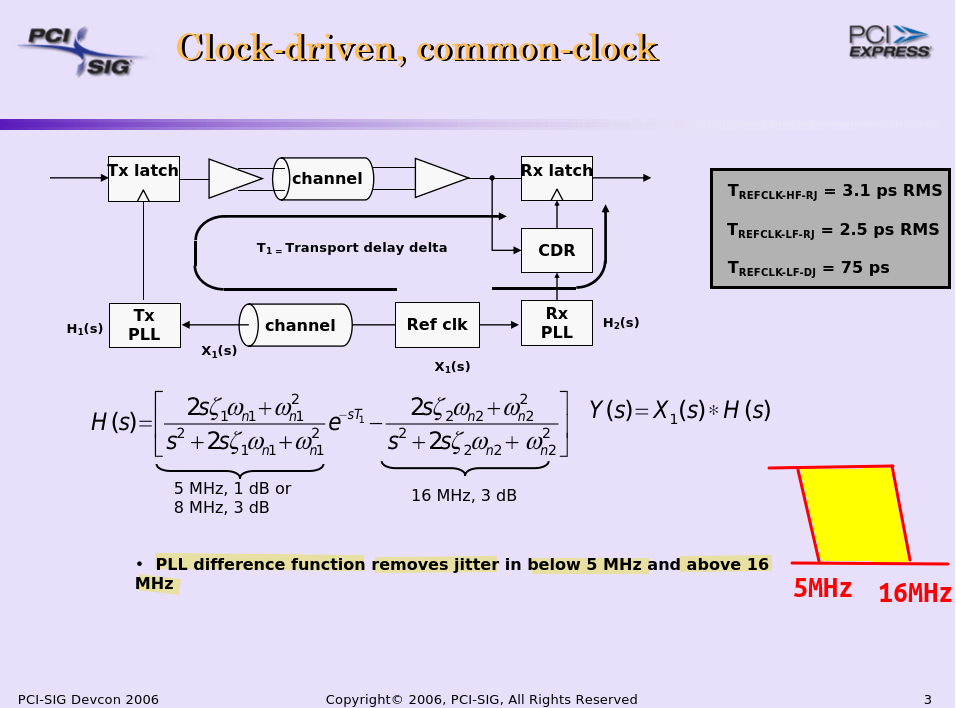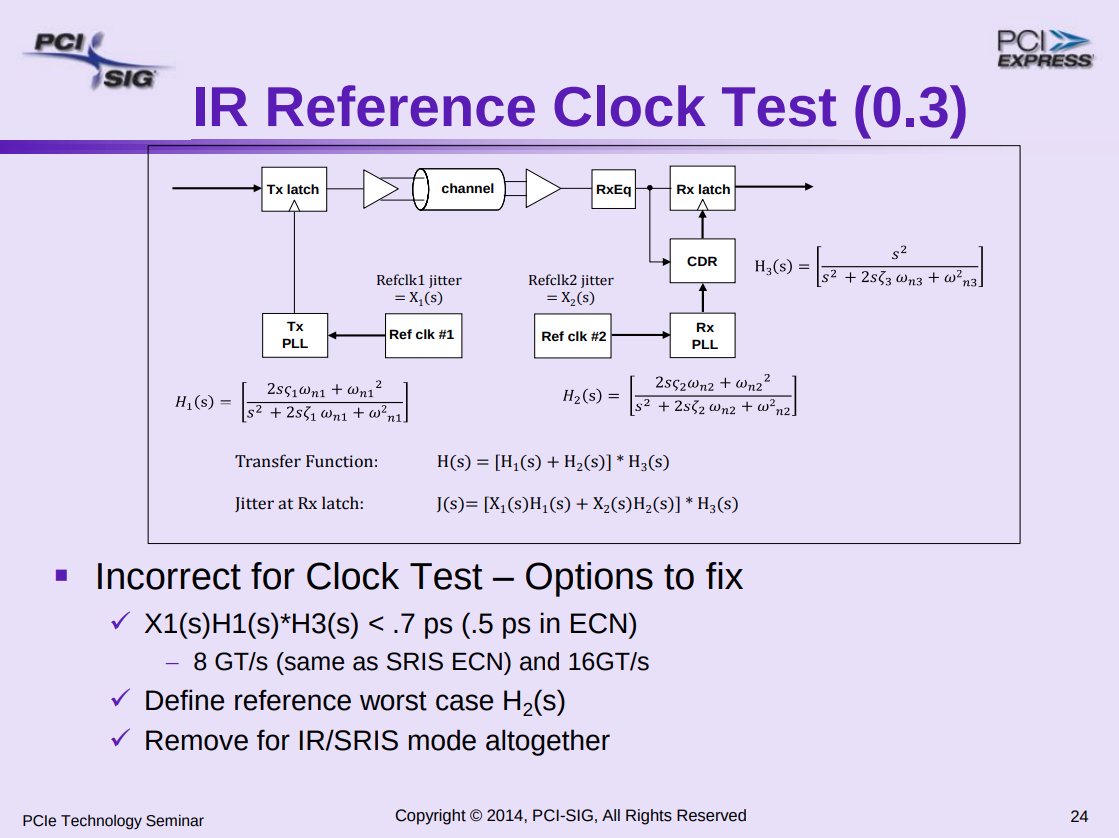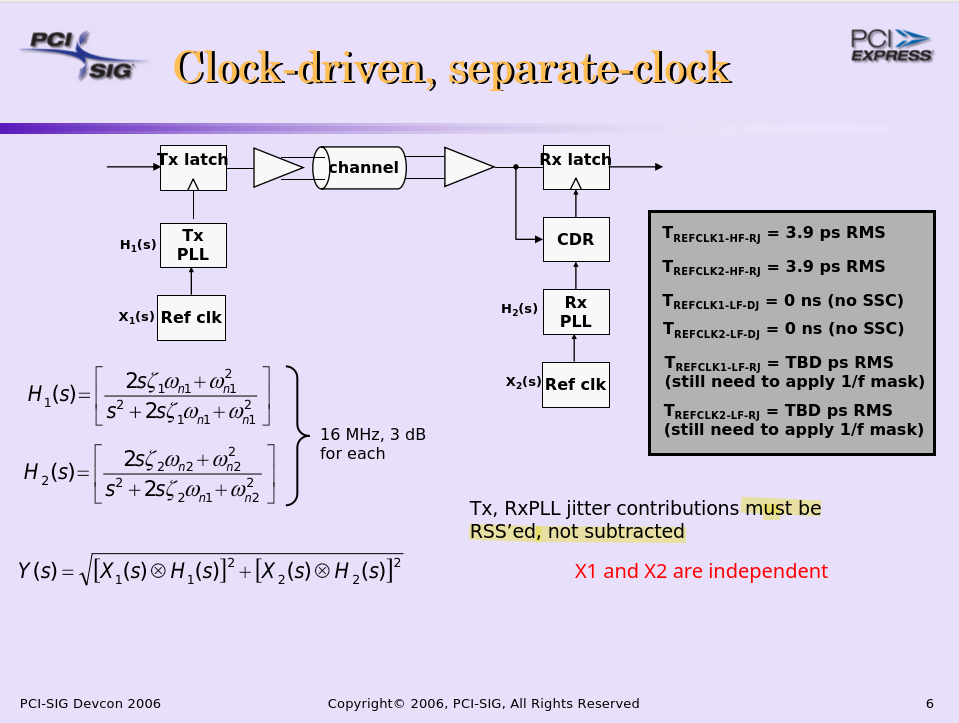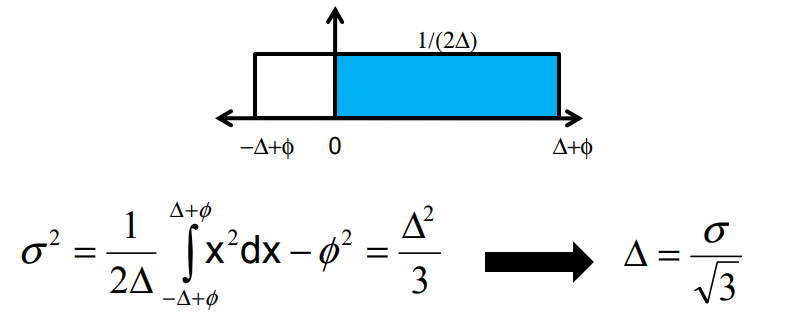Link Budgets & Models
Refclk Specifications & Clocking Architectures
PCI Express Base Specification Revision 3.0
Jeff Morriss, Intel Gerry Talbot, AMD. PCI-SIG Devcon 2006. Jitter Budgeting for Clock Architecture
Verification of SRIS/SRNS Clocking [https://www.esaindia.com/emailer/download/sria-srns-white-paper-final-v3.pdf]
Common Reference Clock (CC)
Common Refclk Rx architectures are characterized by the Tx and Rx sharing the same Refclk source
Most of the SSC jitter sourced by the Refclk is propagated equally through Tx and Rx PLLs, and so intrinsically tracks LF jitter
The amount of jitter appearing at the CDR is then defined by the difference function between the Tx and Rx PLLs multiplied by the CDR highpass characteristic
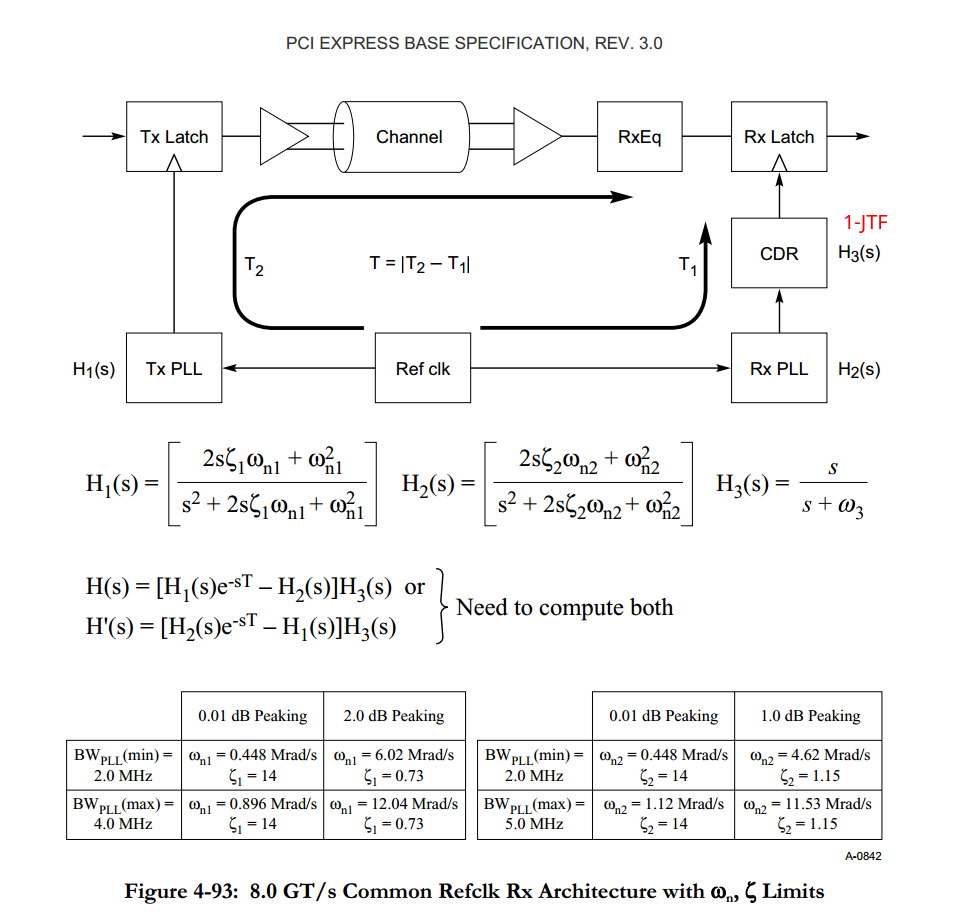 \[
H(s)= H_1(s)e^{-sT} - \left[H_1(s)e^{-sT}(1-H_3(s)) + H_2(s)H_3(s)
\right] = [H_1(s)e^{-sT} -H_2(s)]H_3(s)
\] where \(H_3(s)\) is similar
to \(NTF_{VCO}\), \(1-H_3(s)\) is similar to \(NTF_{REF}\)
\[
H(s)= H_1(s)e^{-sT} - \left[H_1(s)e^{-sT}(1-H_3(s)) + H_2(s)H_3(s)
\right] = [H_1(s)e^{-sT} -H_2(s)]H_3(s)
\] where \(H_3(s)\) is similar
to \(NTF_{VCO}\), \(1-H_3(s)\) is similar to \(NTF_{REF}\)
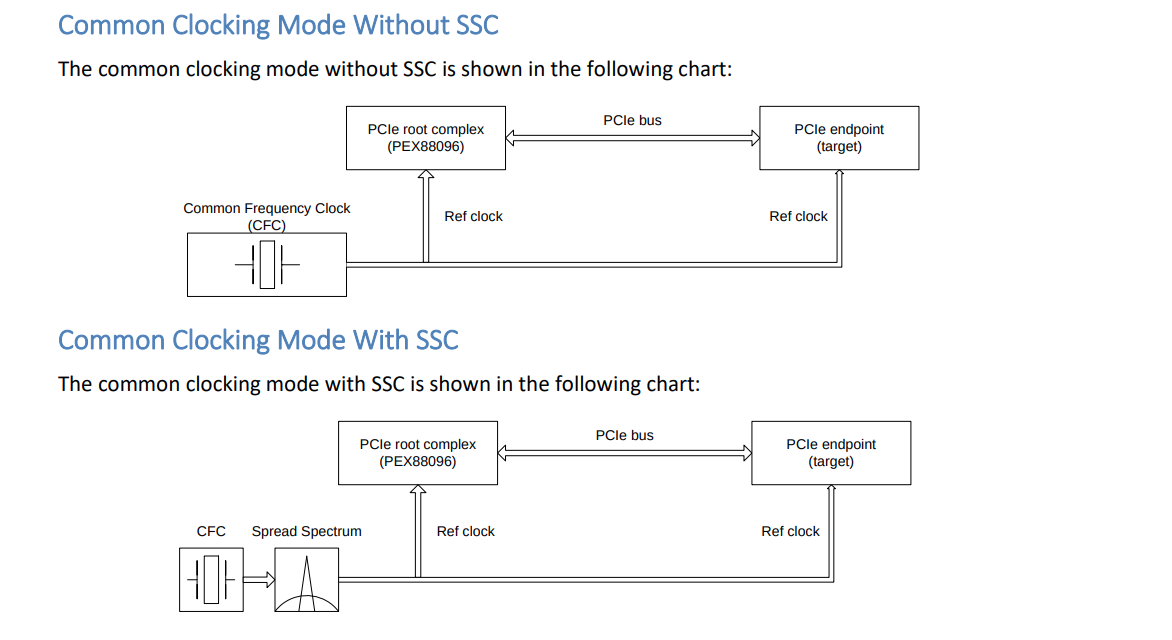
Data Clocked Refclk Rx Architecture
A data clocked Rx architecture is characterized by requiring the receiver's CDR to track the entirety of the low frequency jitter, including SSC
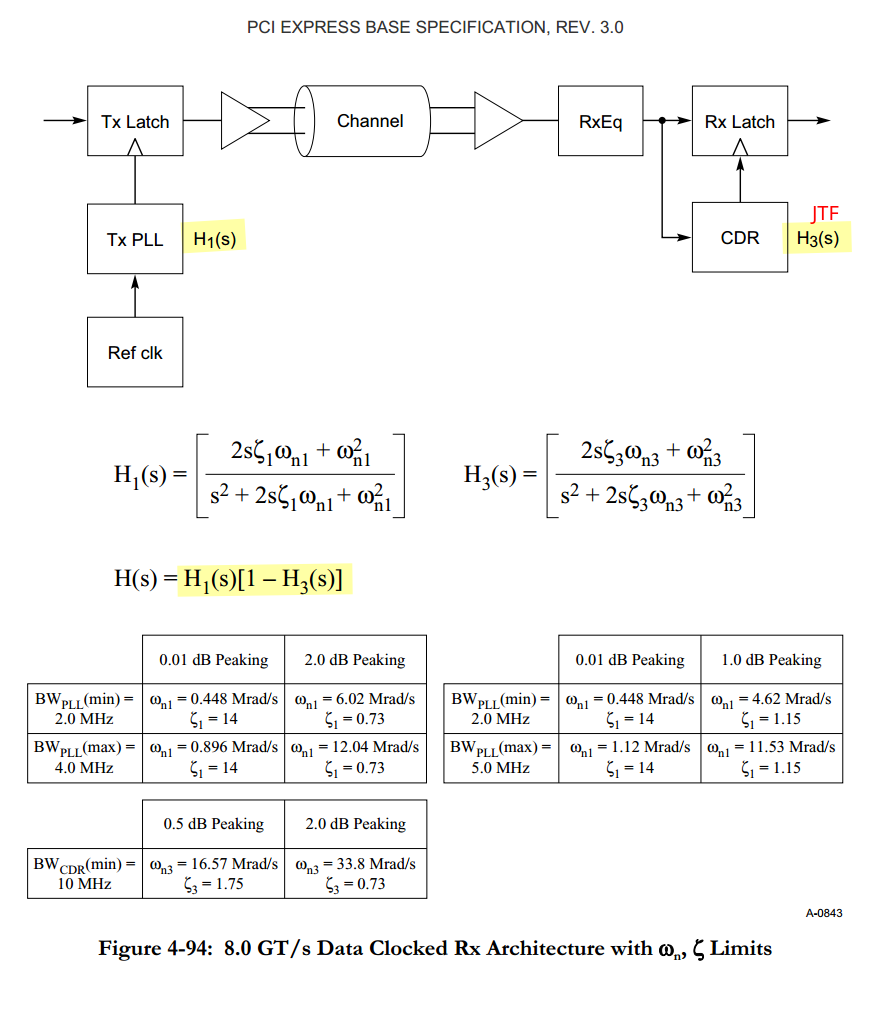
Separate Reference Clocks with SSC (SRIS)
TITLE: Separate Refclk Independent SSC Architecture (SRIS) DATE: Updated 10 January 2013 AFFECTED DOCUMENT: PCI Express Base Spec. Rev. 3.0 SPONSOR: Intel, HP, AMD
 \[\begin{align}
X_{LATCH}(s) &= X_1(s)H_1(s) - \left[X_1(s)H_1(s)(1-H_3(s)) +
X_2(s)H_2(s)H_3(s) \right] \\
& = \left[X_1(s)H_1(s) -X_2(s)H_2(s)\right]H_3(s)
\end{align}\] where \(H_3(s)\)
is similar to \(NTF_{VCO}\), \(1-H_3(s)\) is similar to \(NTF_{REF}\)
\[\begin{align}
X_{LATCH}(s) &= X_1(s)H_1(s) - \left[X_1(s)H_1(s)(1-H_3(s)) +
X_2(s)H_2(s)H_3(s) \right] \\
& = \left[X_1(s)H_1(s) -X_2(s)H_2(s)\right]H_3(s)
\end{align}\] where \(H_3(s)\)
is similar to \(NTF_{VCO}\), \(1-H_3(s)\) is similar to \(NTF_{REF}\)
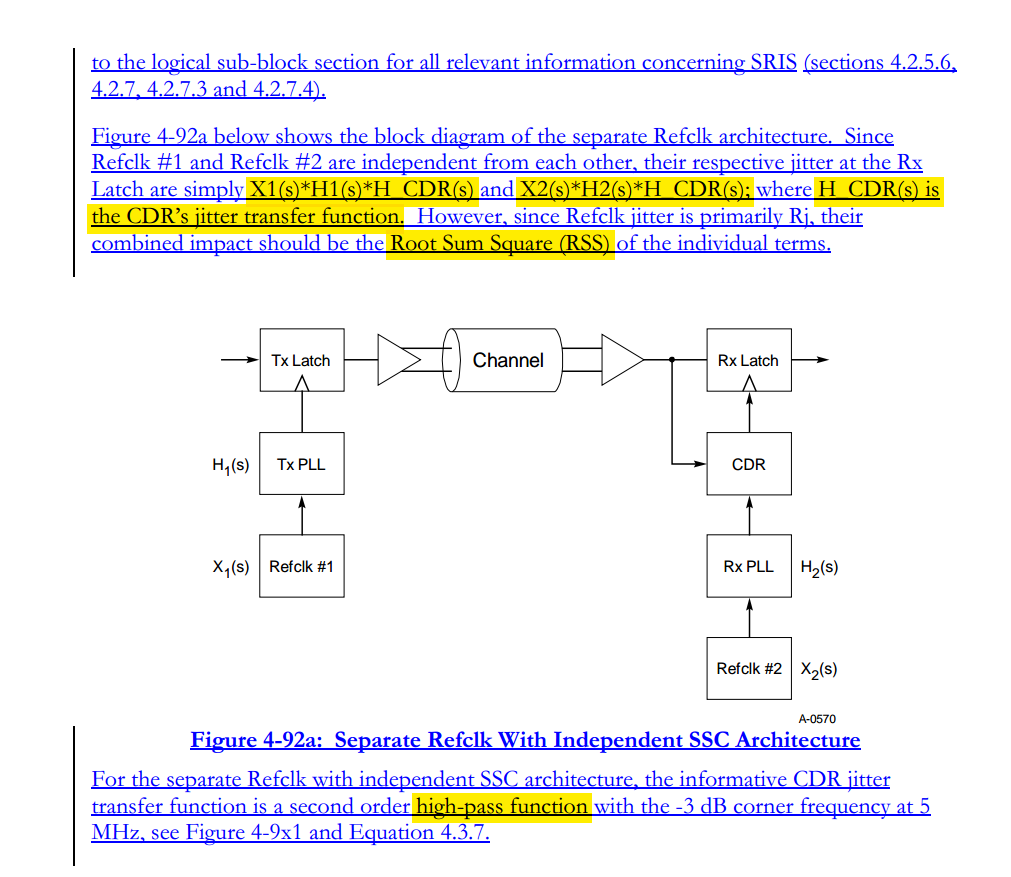
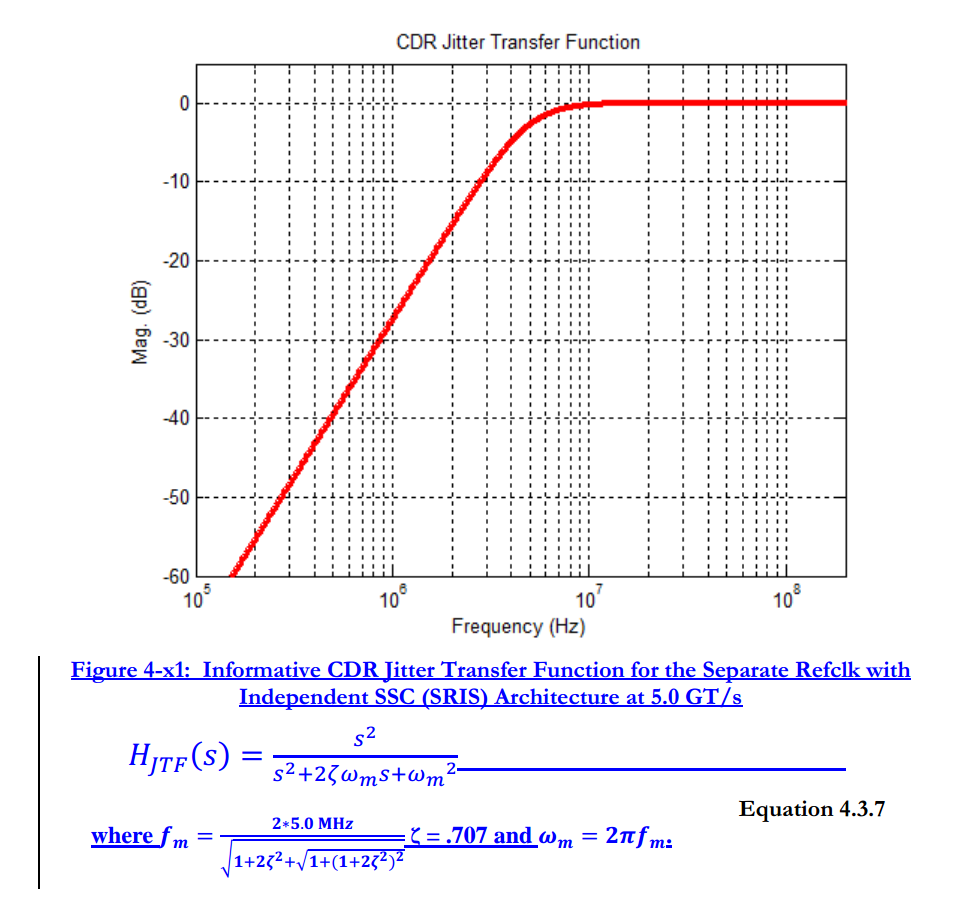
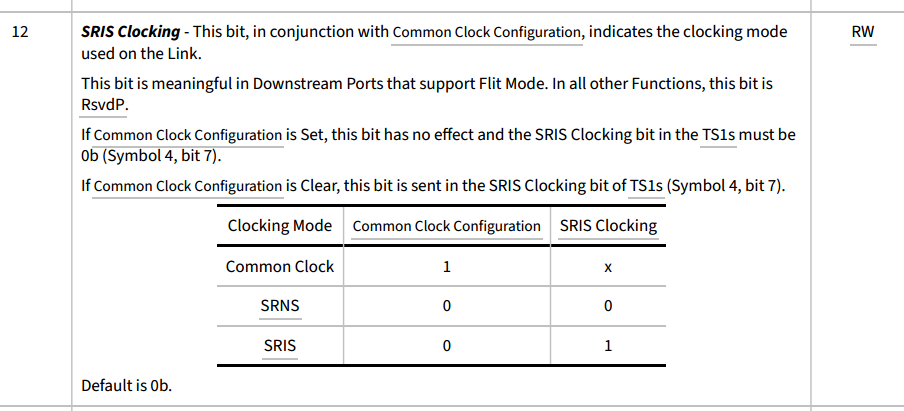

Separate Reference Clocks with No SSC (SRNS)

Low-Latency PCIe
TODO 📅
AC-coupling vs DC-coupling
TODO 📅
Linearity & Even-Order Distortion
Odd-order distortion: symmetry
Even-Order Distortion: non-symmetry (Effect of Mismatch)
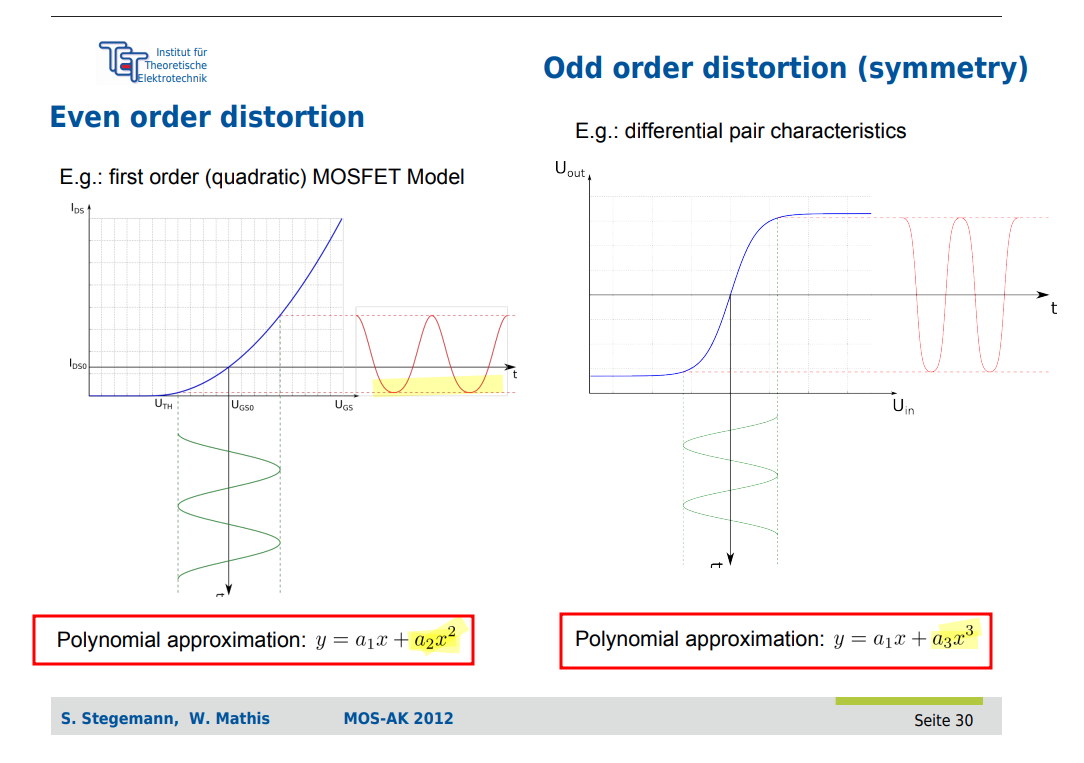
S. Stegemann, W. Mathis. MOS-AK 2012: Interference and Distortion Analysis for Nonlinear Analog Circuits [https://www.mos-ak.org/dresden_2012/publications/T8_Stegemann_MOS-AK_Desden_12.pdf]
Ali Sheikholeslami. A-SSCC 2024 insight: Noise and Distortion, [https://youtu.be/bvsJgHJ19jI?si=1CKDJvTy5EQdPLB4]
B. Razavi, "Design considerations for direct-conversion receivers," in IEEE Transactions on Circuits and Systems II: Analog and Digital Signal Processing, vol. 44, no. 6, pp. 428-435, June 1997 [http://www.seas.ucla.edu/brweb/papers/Journals/RTCAS97.pdf]
[http://cc.ee.ntu.edu.tw/~ecl/Courses/105AIC/lock/Analog_Chapter_09_Nonlinearity%20and%20Mismatch.pdf]
PAM4
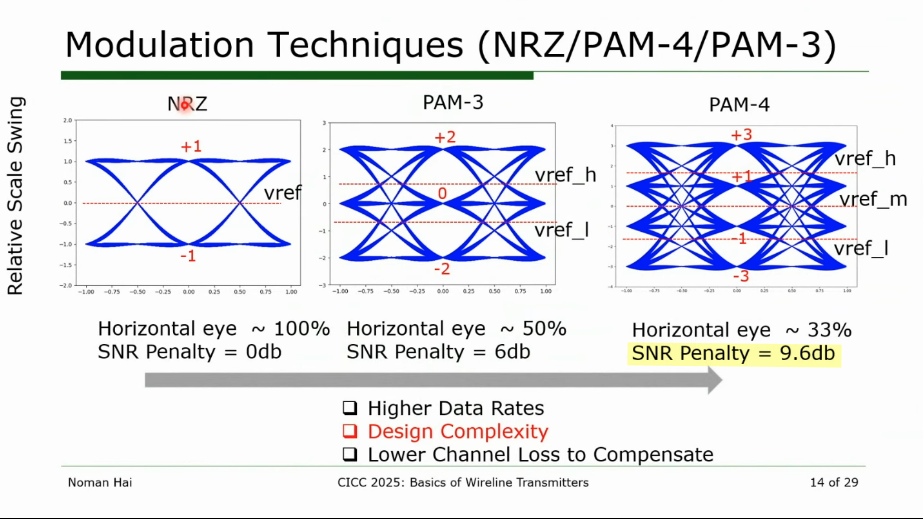

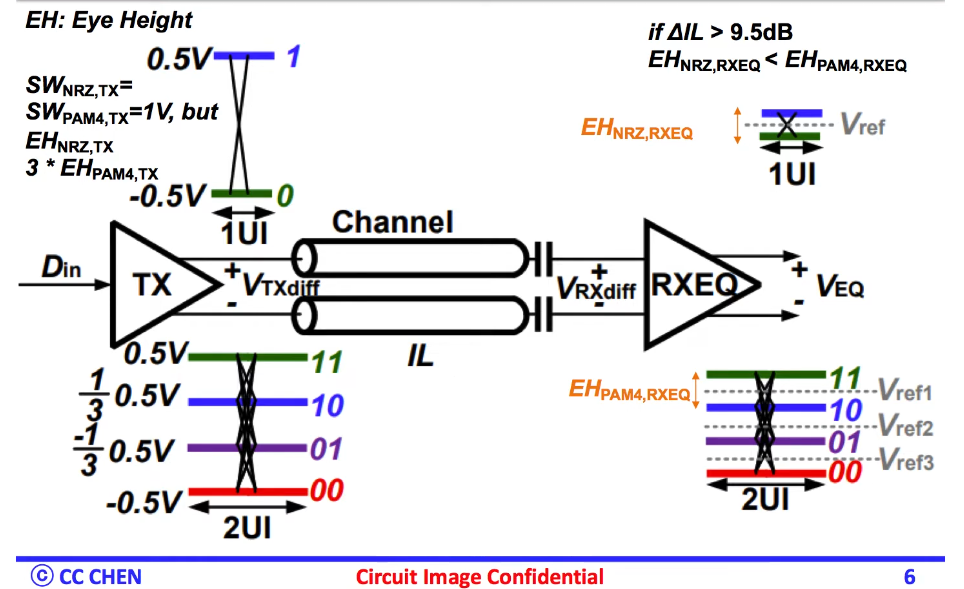
Eye-Diagram and Bit-Error-Ratio (BER)
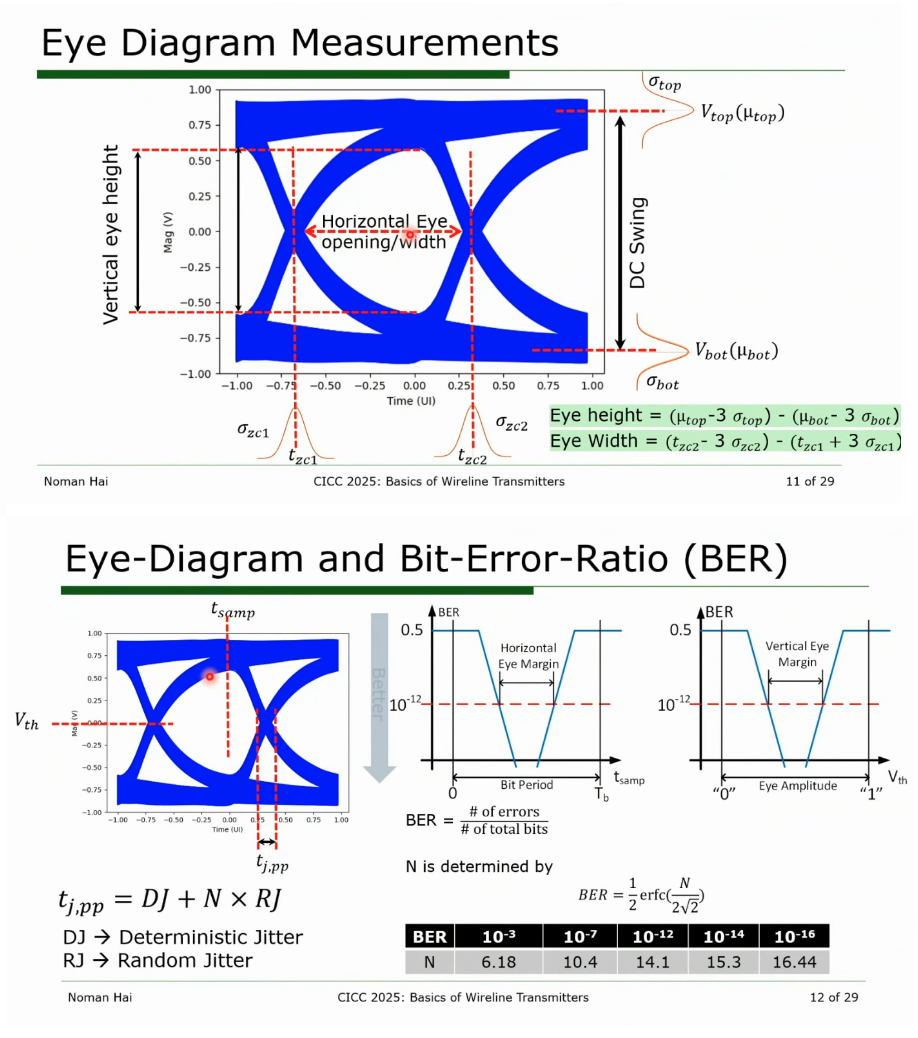
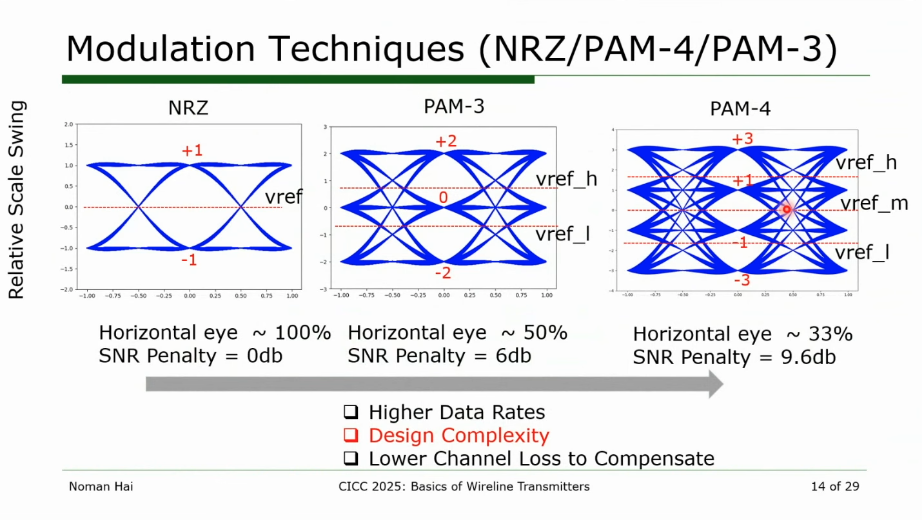
Noman Hai, Synopsys. CICC 2025 Circuit Insights: Basics of Wireline Transmitter Circuits [https://youtu.be/oofViBGlrjM?si=WZnOqtDVG3iDnBHI]
JTOL btw DSP-based vs Analog PAM4 RX
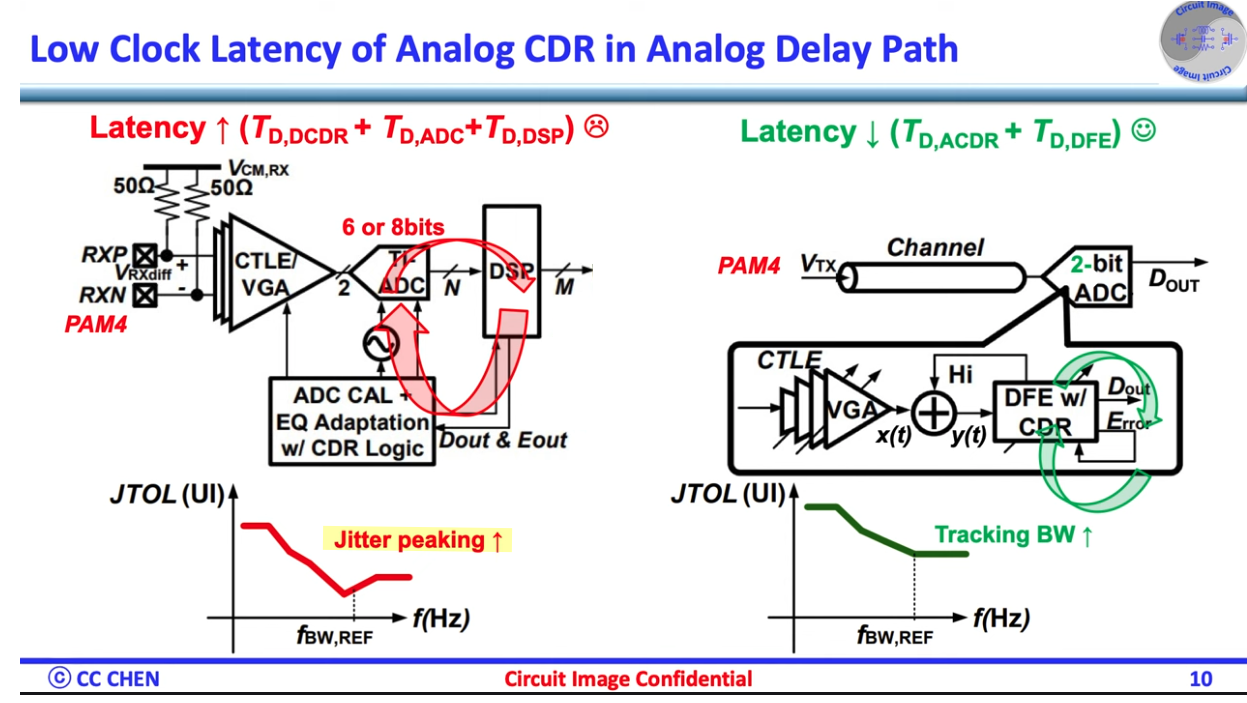
CC Chen, Why Analog PAM4 Receiver? [https://youtu.be/J2ojSMYiuBs?si=7y41W91ciIw_hme2]
challenges in DSP-based SerDes
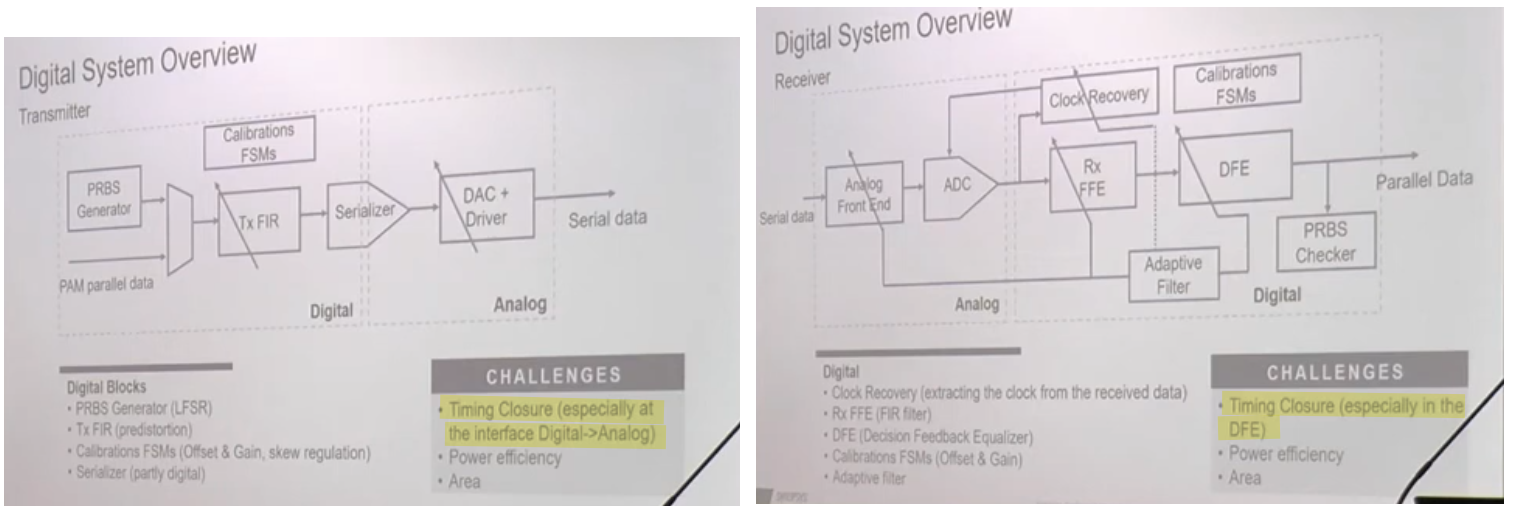
Parallel implementation
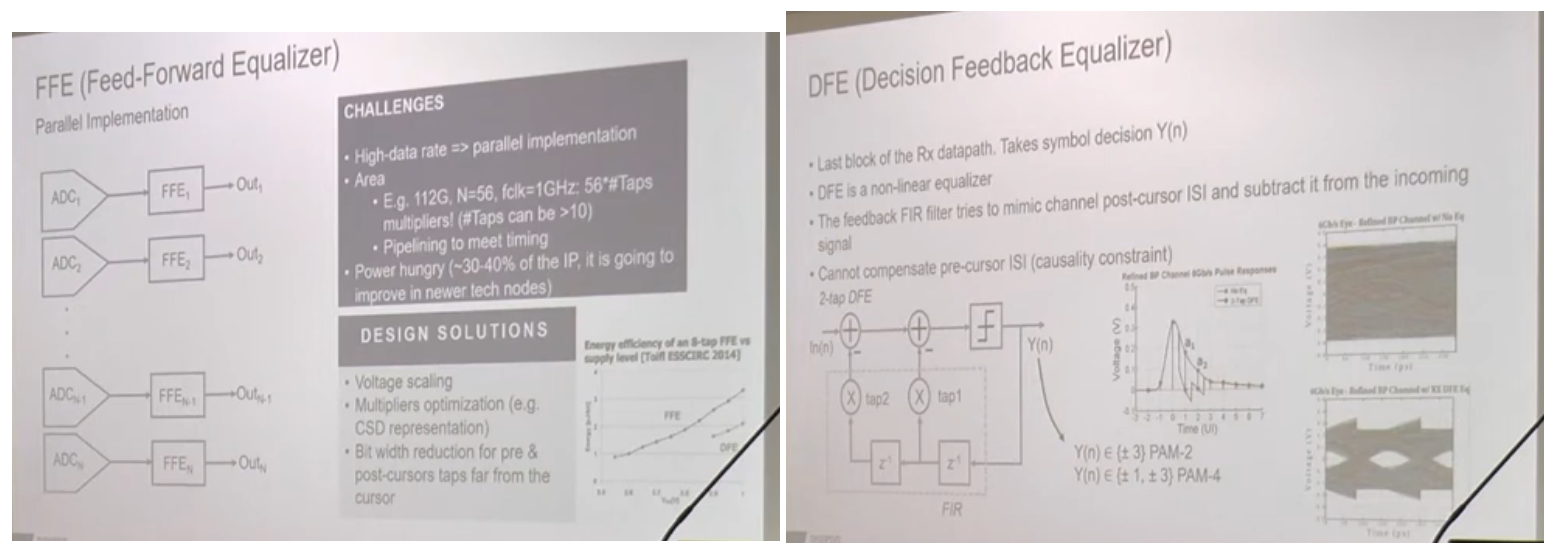
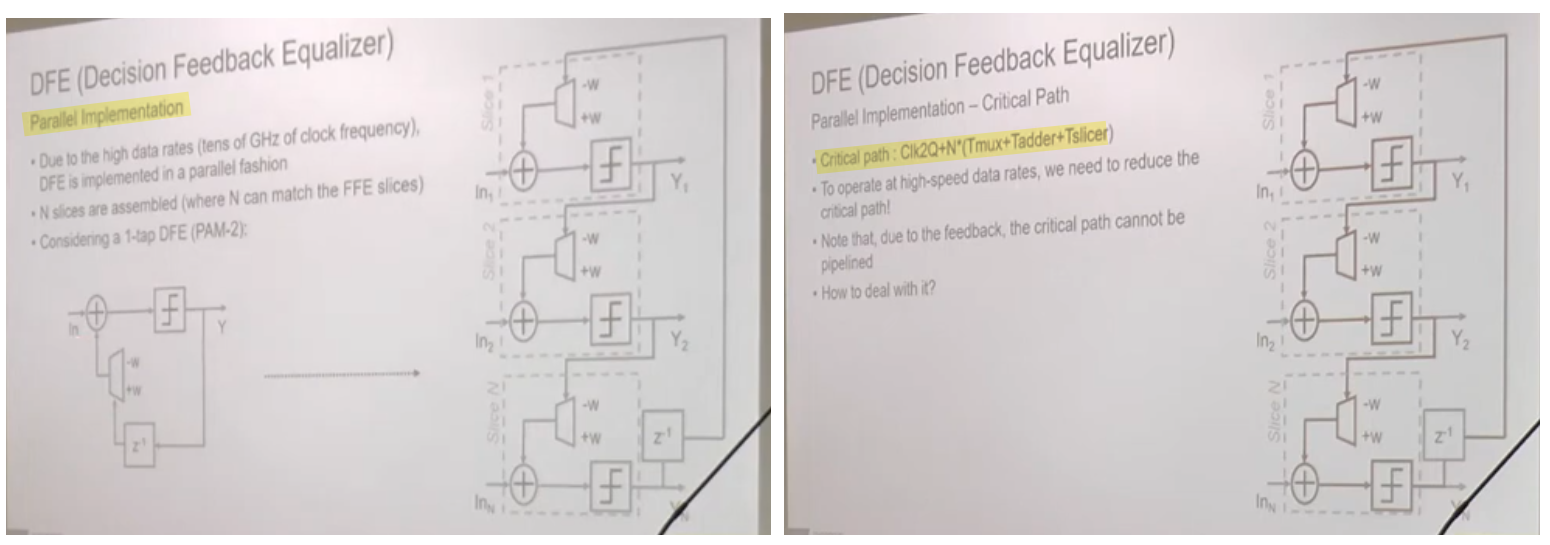
Loop-Unrolling DFE
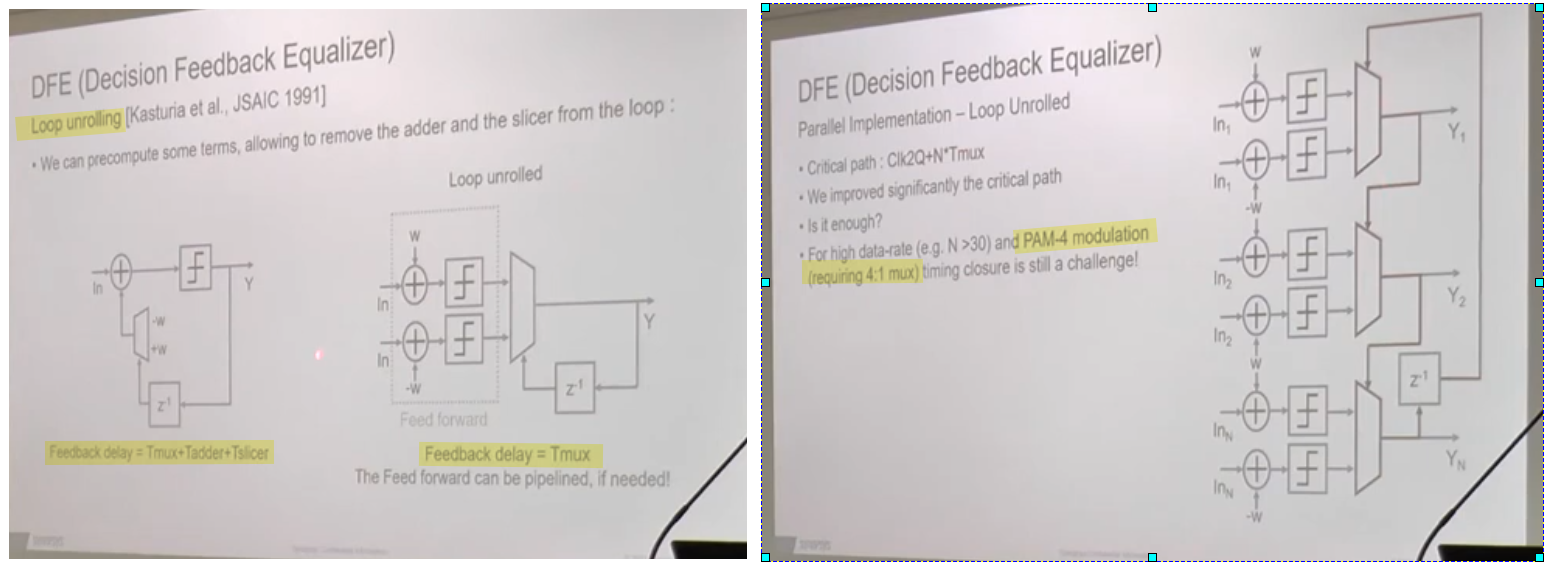
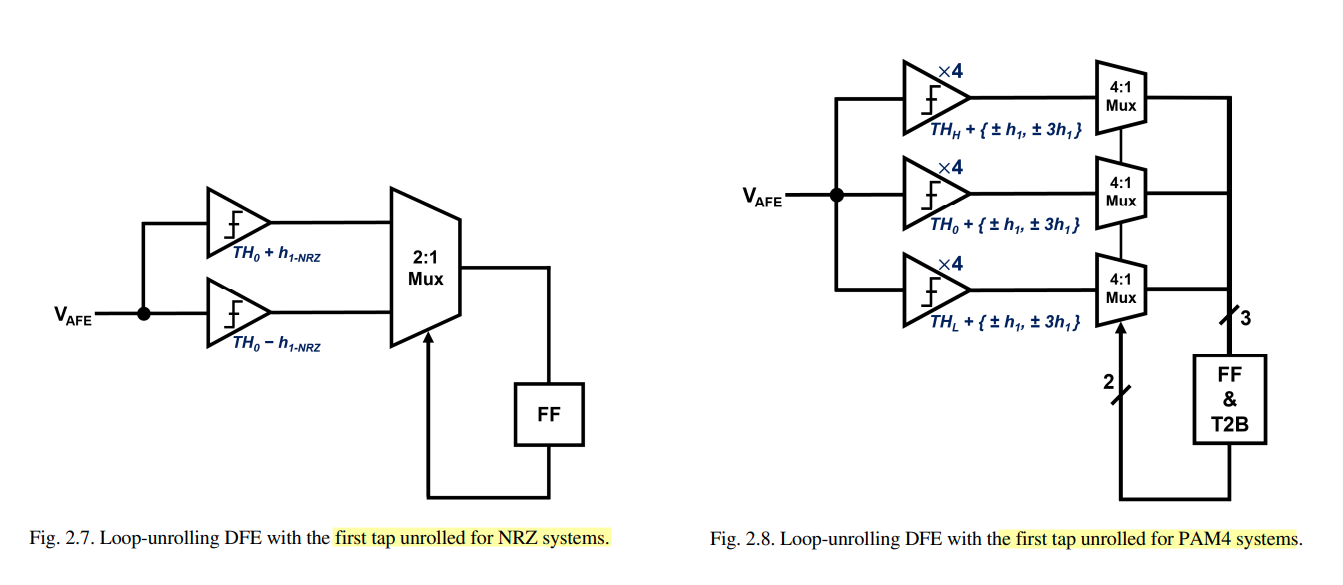
Corresponding to the three distinct voltage thresholds in the PAM4 systems, it would need 12 slicers, 3 multiplexers, and one thermometer-to-binary decoder in each deserialized data path, even if only one tap of the DFE is unrolled
Look-Ahead Multiplexing DFE
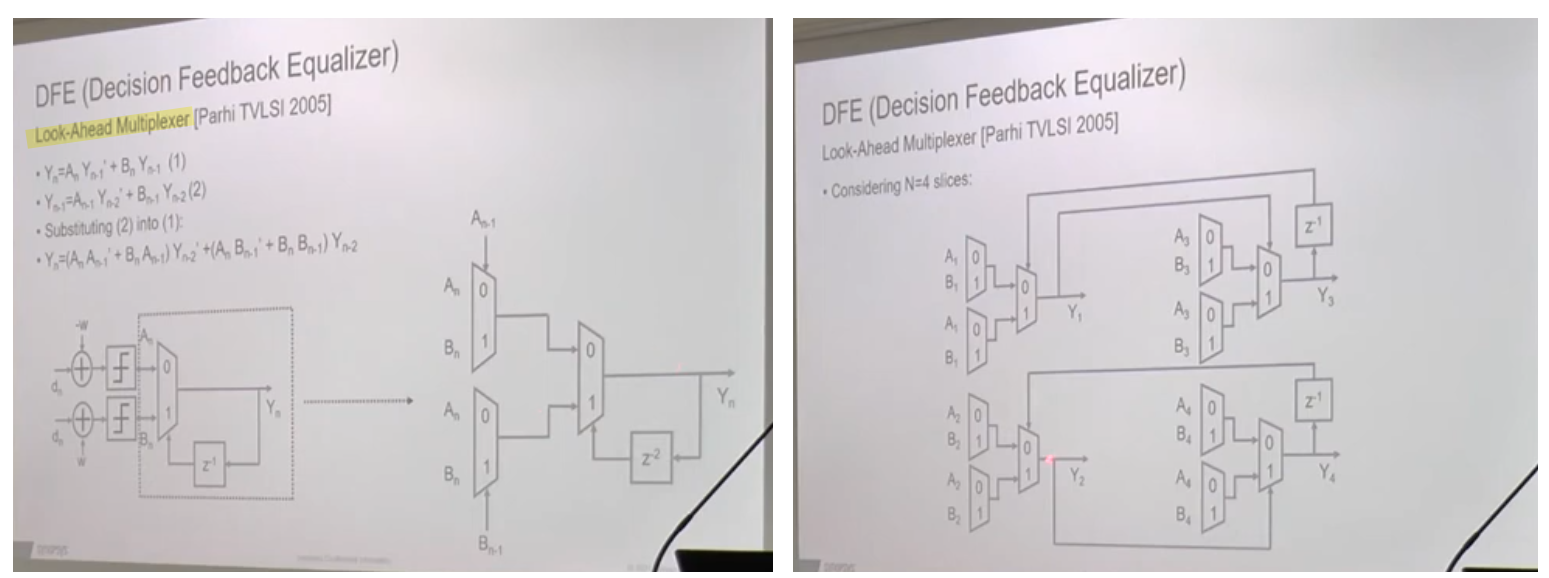
The look-ahead multiplexing technique brings the key benefit that the timing constraint can be significantly relaxed, as the iteration bound is doubled at the expense of extra hardware
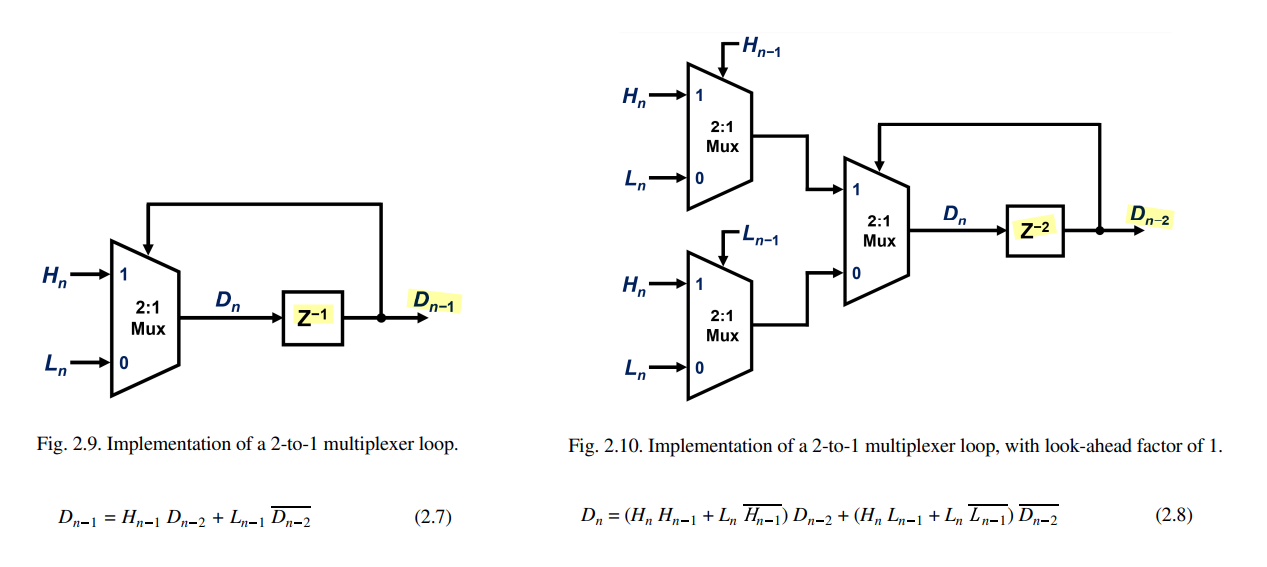
Synopsys Italia, Tech Talk: Introduction to DSP-based SerDes [https://youtu.be/puEP0DlVZGI?si=lFiu1Kl4AKsg3O9f]
Chen, Kuan-Chang (2022) Energy-Efficient Receiver Design for High-Speed Interconnects. Dissertation (Ph.D.), California Institute of Technology. [https://thesis.library.caltech.edu/14318/9/chen_kuan-chang_2022_thesis_final.pdf]
Trellis Coding
TODO 📅
Convolutional Code
TODO 📅
Forward Error Correction (FEC)
It is called "forward" error correction because it can correct errors even in the common situations where there is no backward channel
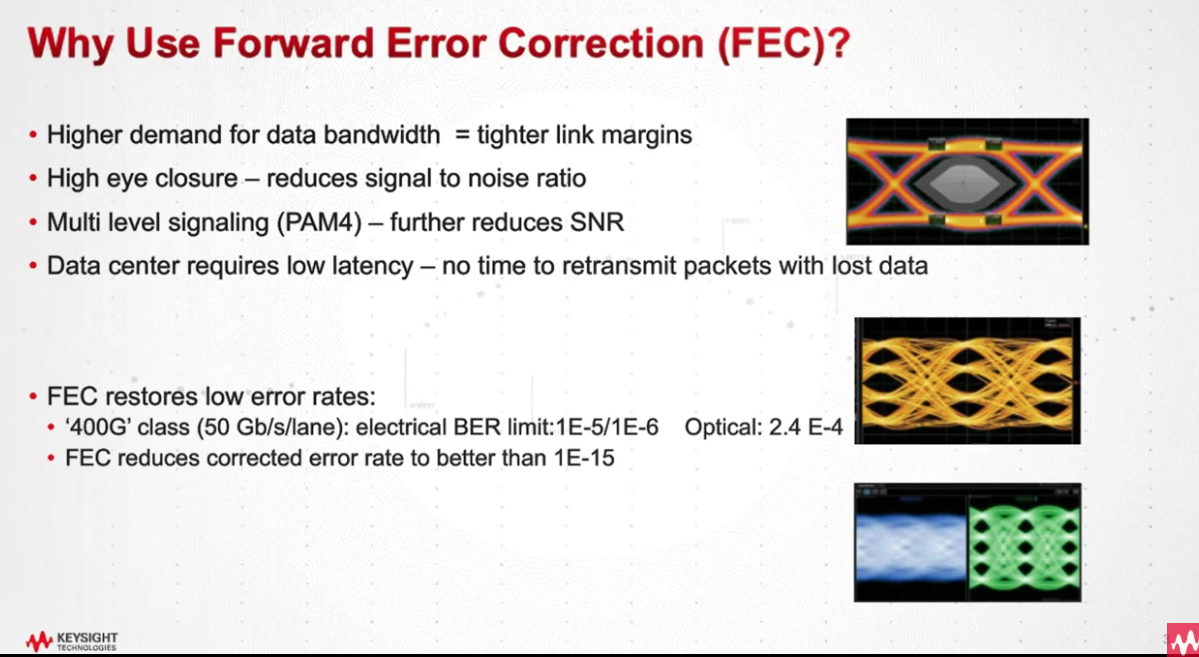
Keysight Technologies. Tutorial – Why Use Forward Error Correction (FEC) [https://youtu.be/56nF4c61KR0?si=jYJSH50q9M3pIvQt]
Paul McLellan, What the FEC is Forward Error Correction? [https://community.cadence.com/cadence_blogs_8/b/breakfast-bytes/posts/fec]
Baseline Wander
TODO 📅
Pete Anslow, Ciena. Baseline wander with FEC [https://www.ieee802.org/3/bs/public/17_05/anslow_3bs_03_0517.pdf]
Vladimir Dmitriev-Zdorov. Baseline Wander, its Time Domain and Statistical Analysis [https://ibis.org/summits/feb19/dmitriev-zdorov.pdf]
Pavel Zivny, Tektronix. Baseline Wander: Systematic Approach to Rapid Simulation and Measurement [pdf]
Update on Performance Studies of 100 Gigabit Ethernet Enabled by Advanced Modulation Formats [https://www.ieee802.org/3/bm/public/sep12/wei_01_0912_optx.pdf]
Sampling Front-End (SFE) Pulse Response
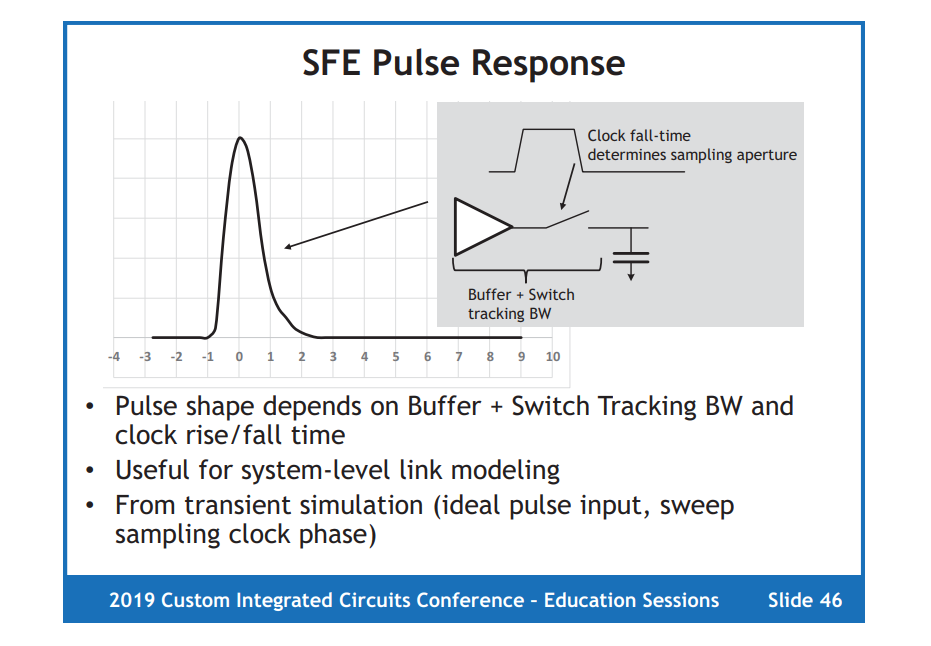
sweep the setup time between ideal pulse input and clock, sample the output of SFE at falling edge
ISI & DDJ filtering
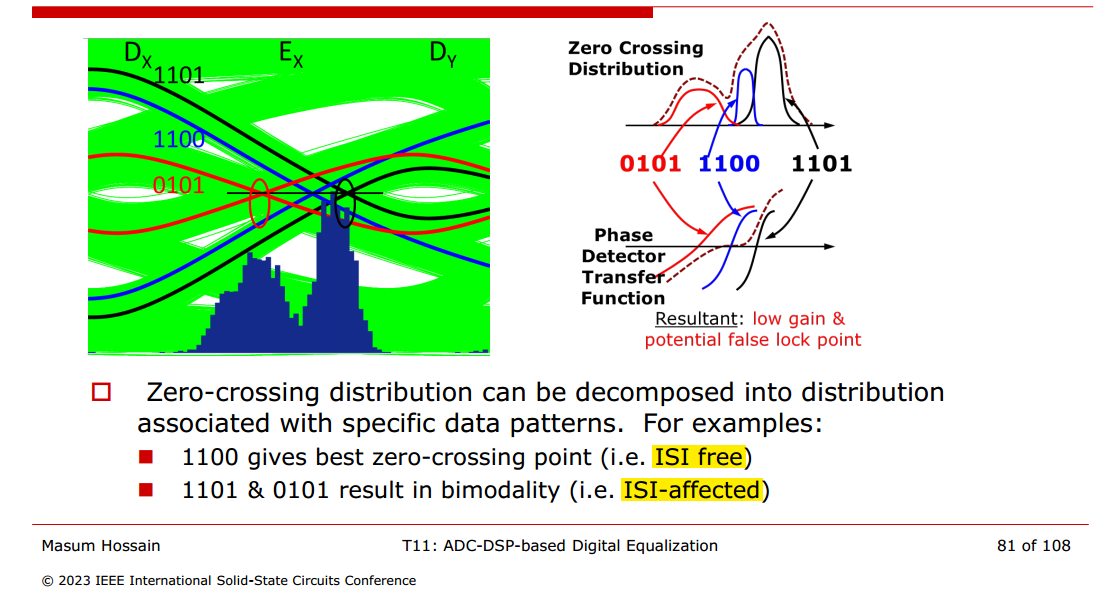
Modulation and SNR
Data and noise mutually uncorrelated
\[ x_{RX,n}[p] = d[p]h_{RX}[0] +\sum \text{ISI} + n[p] \]
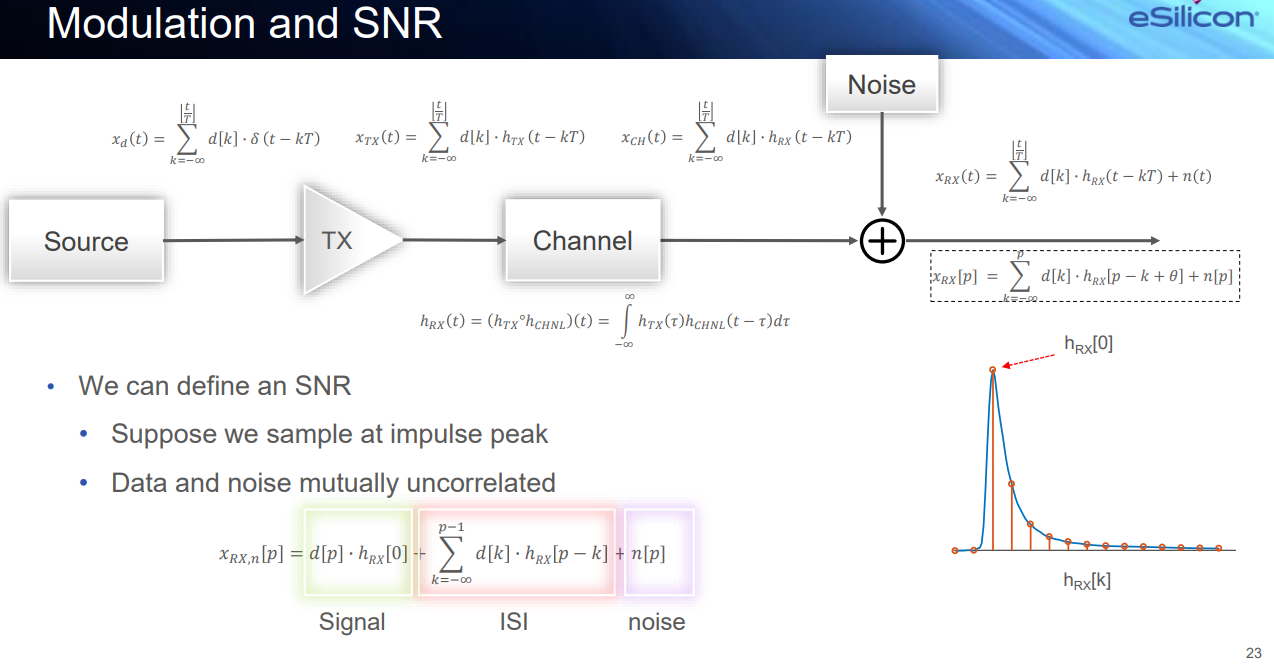
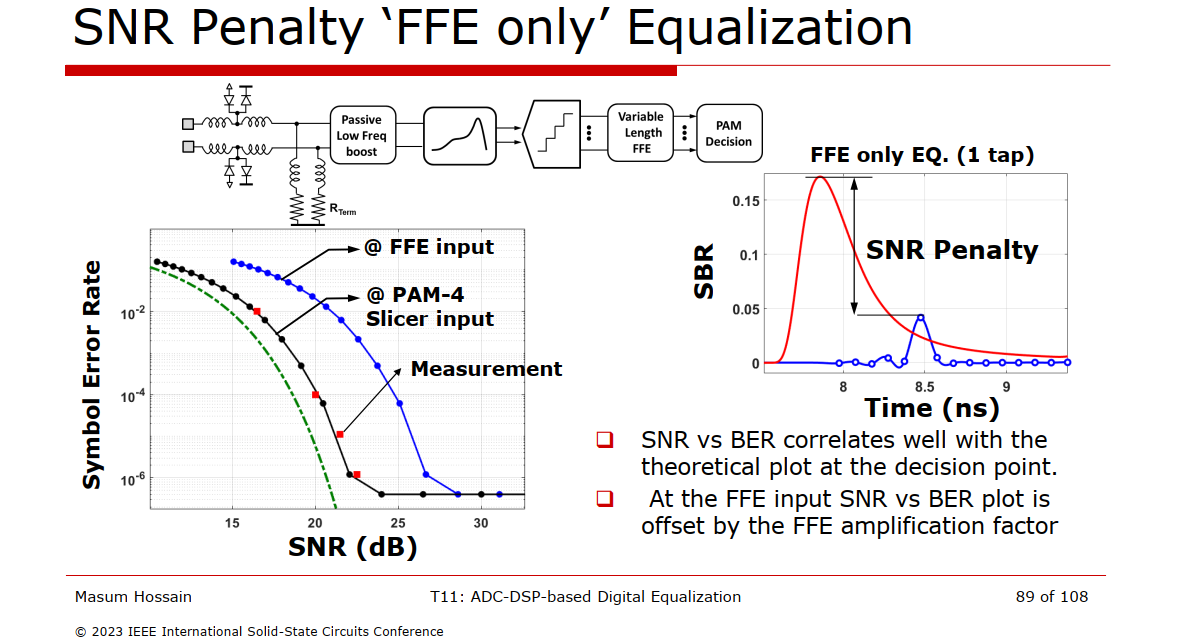
"ISI cancellation" based equalization is conceptually more straightforward but suffers from SNR penalty or error propagation
Jitter Amplification by Passive Channels

Enhancing Resolution with a \(\Delta \Sigma\) Modulator
Sub-Resolution Time Averaging
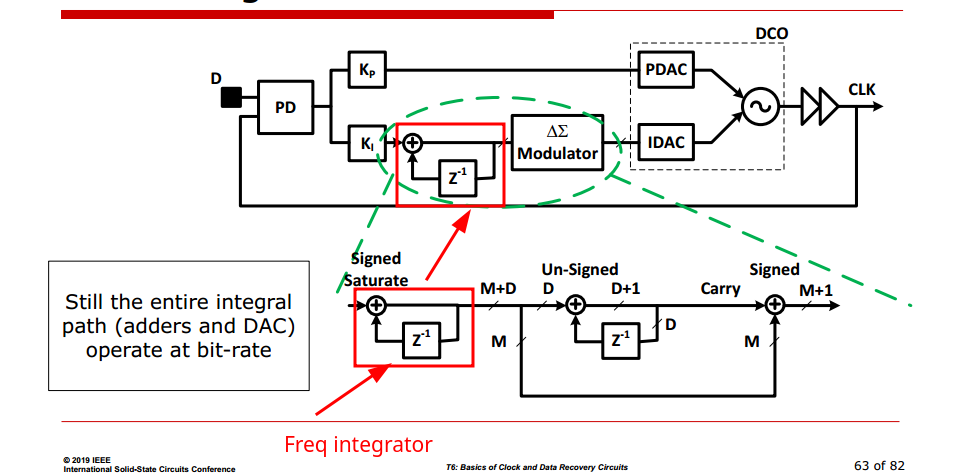
\(\Delta \Sigma\) modulator effectively dithers the LSB bit between zero and one, such that you can get the effective resolution of a much higher resolution DAC in the number of bits
Decimation
how they affect sampling phase

DLF's input bit-width can be reduced by decimating BBPD's output. Decimation is typically performed by realizing either majority voting (MV) or boxcar filtering.
Note that deserialization is inherent to both MV and boxcar filtering
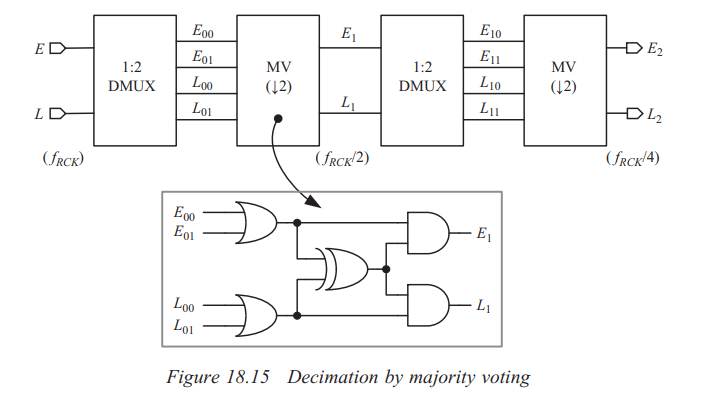
- Decimation is commonly employed to alleviate the high-speed requirement. However, decimation increases loop-latency which causes excessive dither jitter.
- Decimation is basically, widen the data and slowing it down
- Decimating by \(L\) means frequency register only added once every \(L\) UI, thus integral path gain reduced by \(L\) in linear model
- proportional path gain is unchanged
CDR Linear Model
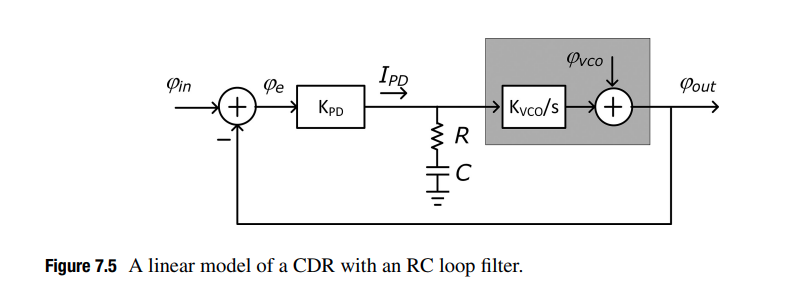
condition:
Linear model of the CDR is used in a frequency lock condition and is approaching to achieve phase lock
Using this model, the power spectral density (PSD) of jitter in the recovered clock \(S_{out}(f)\) is \[ S_{out}(f)=|H_T(f)|^2S_{in}(f)+|H_G(f)|^2S_{VCO}(f) \] Here, we assume \(\varphi_{in}\) and \(\varphi_{VCO}\) are uncorrelated as they come from independent sources.
Jitter Transfer Function (JTF)
\[ H_T(s) = \frac{\varphi_{out}(s)}{\varphi_{in}(s)}|_{\varphi_{vco}=0}=\frac{K_{PD}K_{VCO}R_s+\frac{K_{PD}K_{VCO}}{C}}{s^2+K_{PD}K_{VCO}R_s+\frac{K_{PD}K_{VCO}}{C}} \]
Using below notation \[\begin{align} \omega_n^2=\frac{K_{PD}K_{VCO}}{C} \\ \xi=\frac{K_{PD}K_{VCO}}{2\omega_n^2} \end{align}\]
We can rewrite transfer function as follows \[ H_T(s)=\frac{2\xi\omega_n s+\omega_n^2}{s^2+2\xi \omega_n s+\omega_n^2} \]
The jitter transfer represents a low-pass filter whose magnitude is around 1 (0 dB) for low jitter frequencies and drops at 20 dB/decade for frequencies above \(\omega_n\)
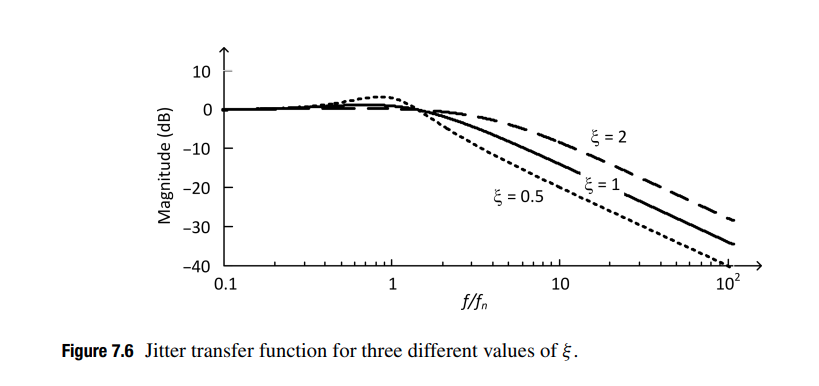
- the recovered clock track the low-frequency jitter of the input data
- the recovered clock DONT track the high-frequency jitter of the input data
The recovered clock does not suffer from high-frequency jitter even though the input signal may contain high-frequency jitter, which will limit the CDR tolerance to high-frequency jitter.
Jitter Peaking in Jitter Transfer Function
The peak, slightly larger than 1 (0dB) implies that jitter will be amplified at some frequencies in the CDR, producing a jitter amplitude in the recovered clock, and thus also in the recovered data, that is slightly larger than the jitter amplitude in the input data.
This is certainly undesirable, especially in applications such as repeaters.
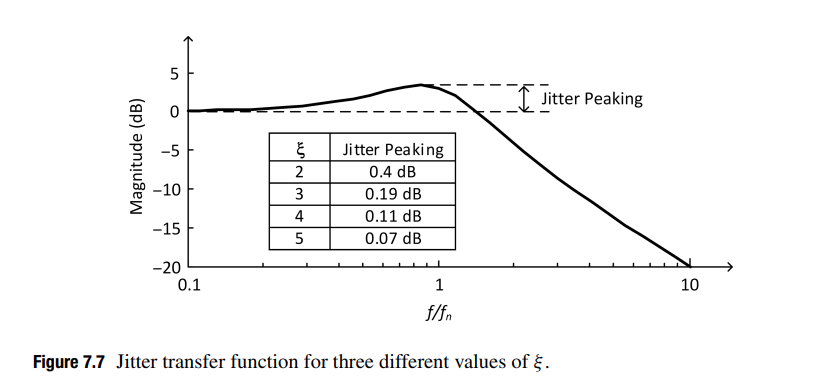
Jitter Generation
If the input data to the CDR is clean with no jitter, i.e., \(\varphi_{in}=0\), the jitter of the recovered clock comes directly from the VCO jitter. The transfer function that relates the VCO jitter to the recovered clock jitter is known as jitter generation. \[ H_G(s)=\frac{\varphi_{out}}{\varphi_{VCO}}|_{\varphi_{in}=0}=\frac{s^2}{s^2+2\xi \omega_n s+\omega_n^2} \] Jitter generation is high-pass filter with two zeros, at zero frequency, and two poles identical to those of the jitter transfer function
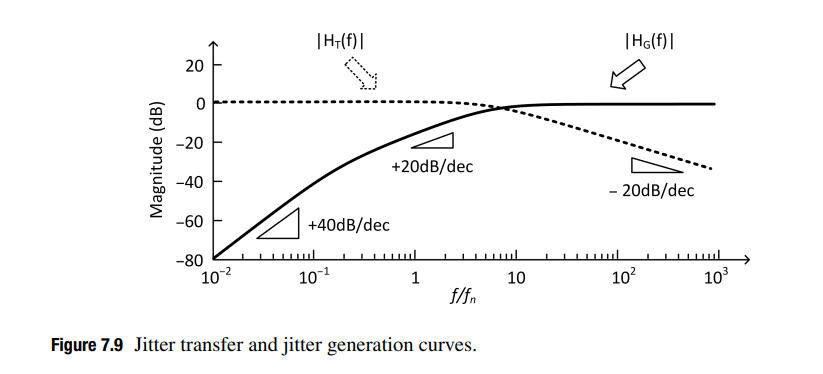
Jitter Tolerance (JTOL)
To quantify jitter tolerance, we often apply a sinusoidal jitter of a fixed frequency to the CDR input data and observe the BER of the CDR
The jitter tolerance curve DONT capture a CDR's true tolerance to random jitter. Because we are applying "sinusoidal" jitter, which is deterministic signal.
We can deal only with the jitter's amplitude and frequency instead of
the PSD of the jitter thanks to deterministic sinusoidal jitter signal.
\[
JTOL(f) = \left | \varphi_{in}(f) \right |_{\text{pp-max}} \quad
\text{for a fixed BER}
\] Where the subscript \(\text{pp-max}\) indicates the
maximum peak-to-peak amplitude. We can further expand
this equation as follows \[
JTOL(f)=\left| \frac{\varphi_{in}(f)}{\varphi_{e}(f)} \right| \cdot
|\varphi_e(f)|_\text{pp-max}
\] 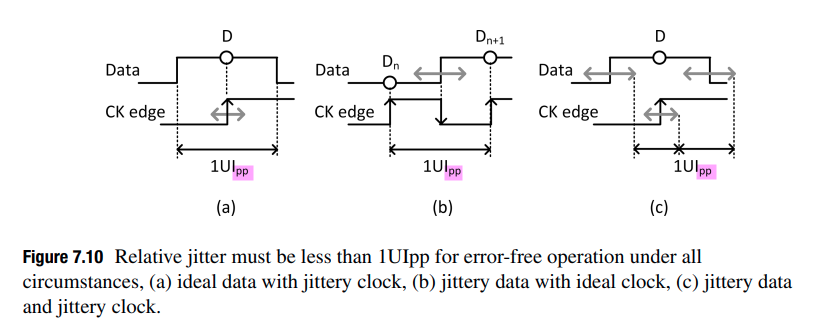
Relative jitter, \(\varphi_e\) must be less than 1UIpp for error-free operation
In an ideal CDR, the maximum peak-to-peak amplitude of \(|\varphi_e(f)|\) is 1UI, i.e.,\(|\varphi_e(f)|_\text{pp-max}=1UI\)
Accordingly, jitter tolerance can be expressed in terms of the number of UIs as \[ JTOL(f)=\left| \frac{\varphi_{in}(f)}{\varphi_{e}(f)} \right|\quad \text{[UI]} \] Given the linear CDR model, we can write \[ JTOL(f)=\left| 1+\frac{K_{PD}K_{VCO}H_{LF}(f)}{j2\pi f} \right|\quad \text{[UI]} \] Expand \(H_{LF}(f)\) for the CDR, we can write \[ JTOL(f)=\left| 1-2\xi j \left(\frac{f_n}{f}\right) - \left(\frac{f_n}{f}\right)^2 \right|\quad \text{[UI]} \] At frequencies far below and above the natural frequency, the jitter tolerance can be approximated by the following \[ JTOL(f) = \left\{ \begin{array}{cl} \left(\frac{f_n}{f}\right)^2 & : \ f\ll f_n \\ 1 & : \ f\gg f_n \end{array} \right. \]
the jitter tolerance at very high jitter frequencies is limited to 1UIpp
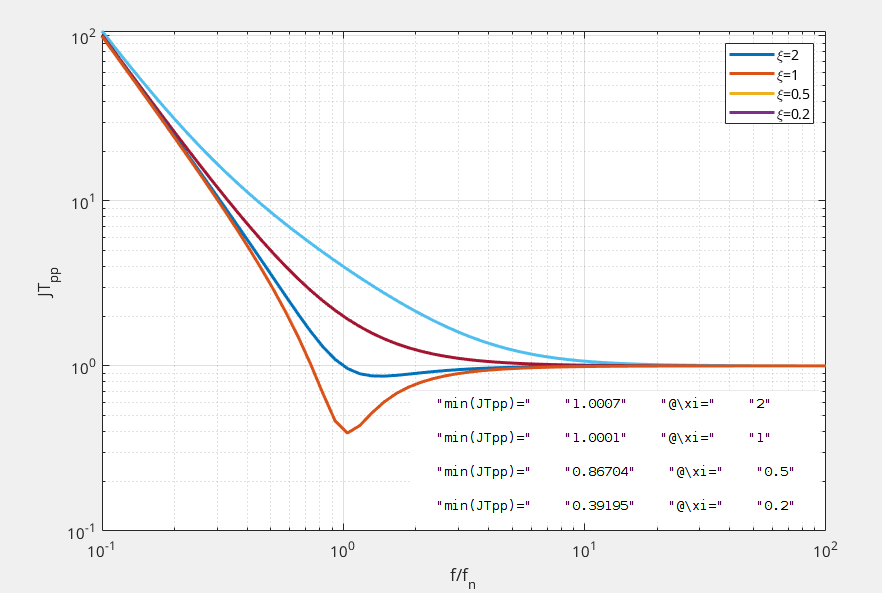
1 | clc; |
CC Chen, Circuit Images: Why JTOL in a CDR? [https://youtu.be/kZExm9wy0G8?si=5ULT0t_oHNkp7c2v]
—. Why Pseudo-JTOL in a CDR Design or Verification? [https://youtu.be/DZyzLhk59aY?si=xMcN2Xo3hnCeL3RX]
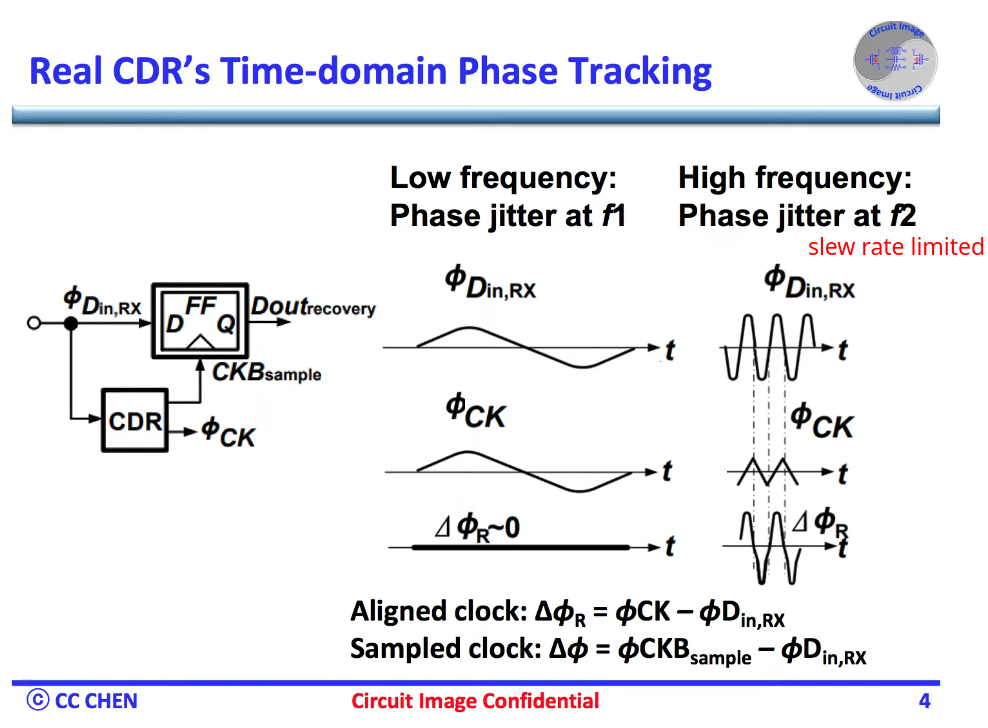
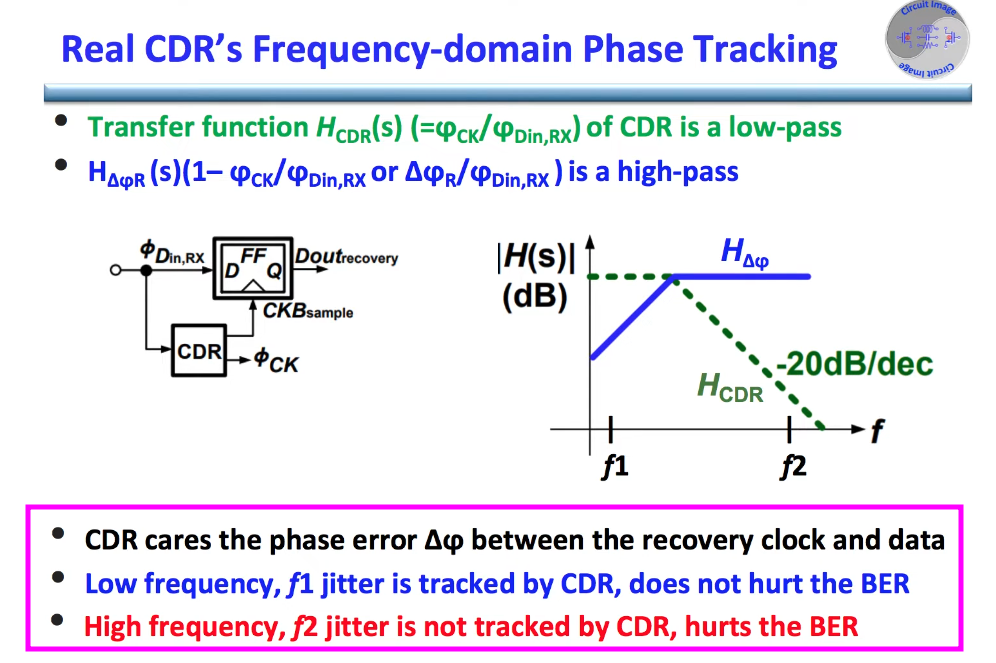
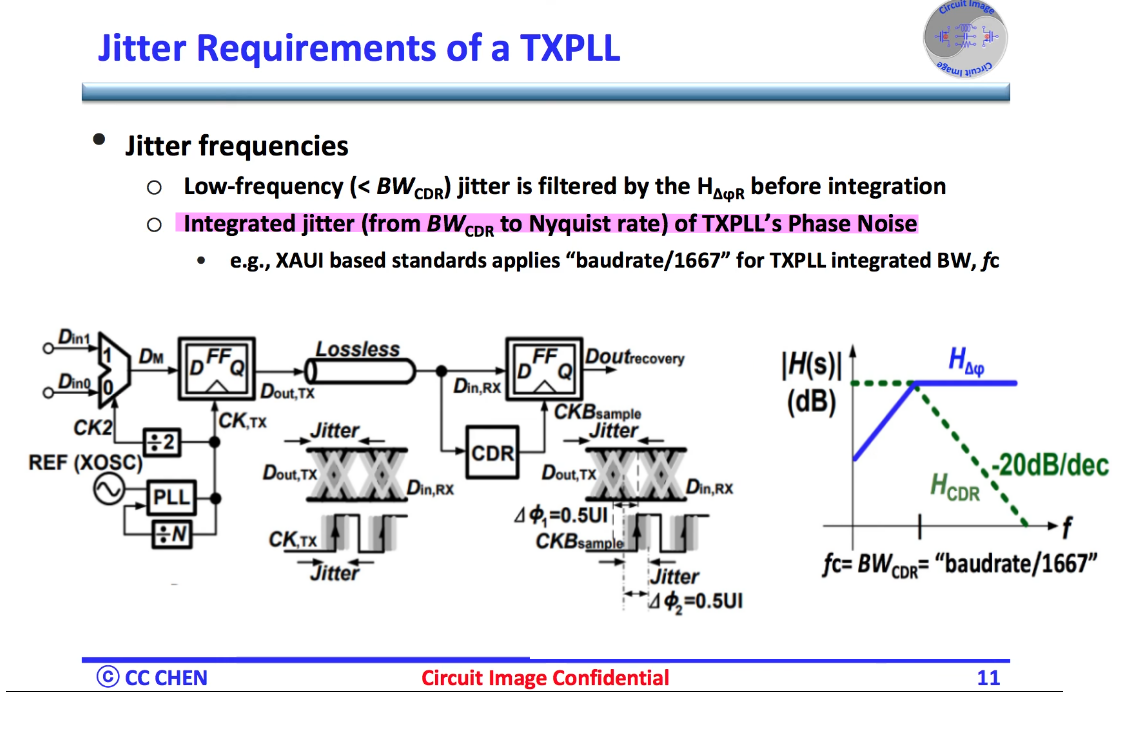
OJTF
Concepts of JTF and OJTF
Simplified Block Diagram of a Clock-Recovery PLL 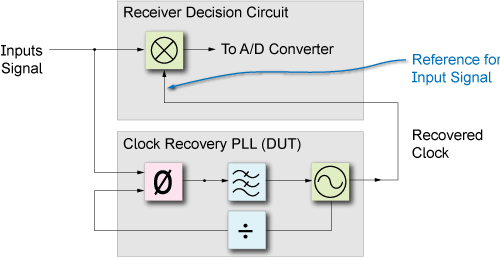
Jitter Transfer Function (JTF)
- Input Signal Versus Recovered Clock
- JTF, by jitter frequency, compares how much input signal jitter is
transferred to the output of a clock-recovery's PLL (recovered
clock)
- Input signal jitter that is within the clock recovery PLL's loop bandwidth results in jitter that is faithfully transferred (closed-loop gain) to the clock recovery PLL's output signal. JTF in this situation is approximately 1.
- Input signal jitter that is outside the clock recovery PLL's loop bandwidth results in decreasing jitter (open-loop gain) on the clock recovery PLL's output, because the jitter is filtered out and no longer reaches the PLL's VCO
Observed Jitter Transfer Function
- Input Signal Versus Sampled Signal
- OJTF compares how much input signal jitter is transferred to the
output of a receiver's decision making circuit as
effected by a clock recovery's PLL. As the recovered clock is the
reference for detecting the input signal
- Input signal jitter that is within the clock recovery PLL's loop bandwidth results in jitter on the recovered clock which reduces the amount of jitter that can be detected. The input signal and clock signal are closer in phase
- Input signal jitter that is outside the clock recovery PLL's loop bandwidth results in reduced jitter on the recovered clock which increases the amount of jitter that can be detected. The input signal and clock signal are more out of phase. Jitter that is on both the input and clock signals can not detected or is reduced
JTF and OJTF for 1st Order PLLs
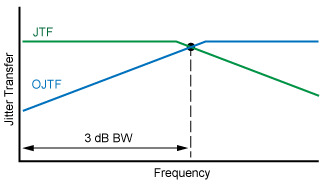

The observed jitter is a complement to the PLL jitter transfer response OJTF=1-JTF (Phase matters!)
OTJF gives the amount of jitter which is tracked and therefore not observed at the output of the CDR as a function of the jitter rate applied to the input.
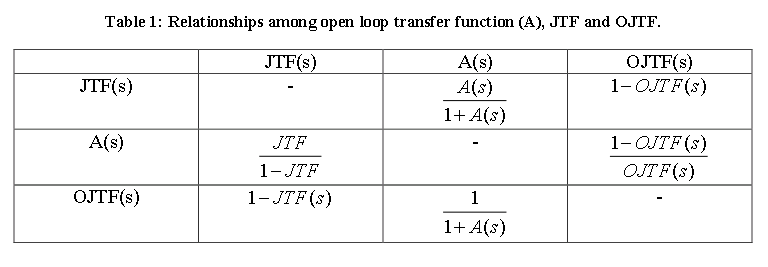
Jitter Measurement
\[ J_{\text{measured}} = JTF_{\text{DUT}} \cdot OJTF_{\text{instrument}} \]
The combination of the OJTF of a jitter measurement device and the JTF of the clock generator under test gives the measured jitter as a function of frequency.
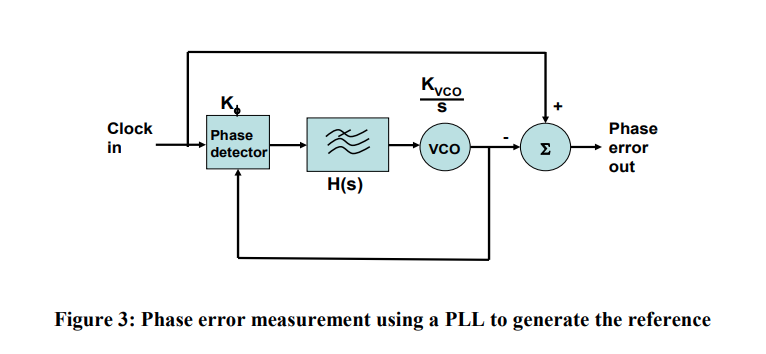
For example, a clock generator with a type 1, 1st order PLL measured with a jitter measurement device employing a golden PLL is \[ J_{\text{measured}} = \frac{\omega_1}{s+\omega_1}\frac{s}{s+\omega_2} \]
Accurate measurement of the clock JTF requires that the OJTF cutoff of the jitter measurement be significantly below that of the clock JTF and that the measurement is compensated for the instrument's OJTF.
The overall response is a band pass filter because the clock JTF is low pass and the jitter measurement device OJTF is high pass.
The compensation for the instrument OJTF is performed by measuring the jitter of the reference clock at each jitter rate being tested and comparing the reference jitter with the jitter measured at the output of the DUT.
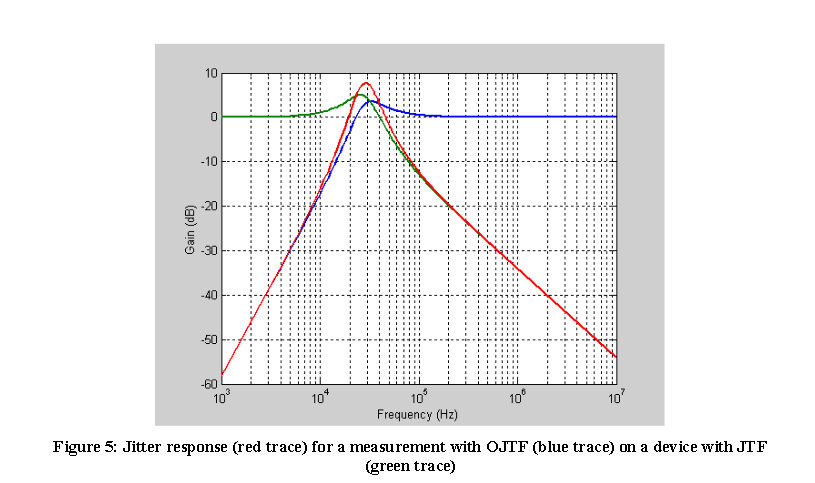
The lower the cutoff frequency of the jitter measurement device the better the accuracy of the measurement will be.
The cutoff frequency is limited by several factors including the phase noise of the DUT and measurement time.
Digital Sampling Oscilloscope
How to analyze jitter:
- TIE (Time Interval Error) track
- histogram
- FFT
TIE track provides a direct view of how the phase of the clock evolves over time.
histogram provides valuable information about the long term variations in the timing.
FFT allows jitter at specific rates to be measured down to the femto-second range.
Maintaining the record length at a minimum of \(1/10\) of the inverse of the PLL loop bandwidth minimizes the response error
reference
Dalt, Nicola Da and Ali Sheikholeslami. “Understanding Jitter and Phase Noise: A Circuits and Systems Perspective.” (2018).
neuhelium, 抖动、眼图和高速数字链路分析基础 URL: http://www.neuhelium.com/ueditor/net/upload/file/20200826/DSOS254A/03.pdf
Keysight JTF & OJTF Concepts, https://rfmw.em.keysight.com/DigitalPhotonics/flexdca/FlexPLL-UG/Content/Topics/Quick-Start/jtf-pll-theory.htm?TocPath=Quick%20Start%7C_____4
Complementary Transmitter and Receiver Jitter Test Methodlogy, URL: https://www.ieee802.org/3/bm/public/mar14/ghiasi_01_0314_optx.pdf
SerDesDesign.com CDR_BangBang_Model URL: https://www.serdesdesign.com/home/web_documents/models/CDR_BangBang_Model.pdf
M. Schnecker, Jitter Transfer Measurement in Clock Circuits, LeCroy Corporation, DesignCon 2009. URL: http://cdn.teledynelecroy.com/files/whitepapers/designcon2009_lecroy_jitter_transfer_measurement_in_clock_circuits.pdf
Link Budgets
VCO model
TODO 📅
respone to vctrl focus on phase
[https://designers-guide.org/verilog-ams/functional-blocks/vco/vco.va]
ADC Spec
TODO 📅
ENOB - Not sufficient & not accurate enough
- Based on SNDR
- Assume unbounded Gaussian distribution
quantization noise is ~ bounded uniform distribution
Using unbounded Gaussian -> pessimistic BER prediction
AFE Nonlinearity
"total harmonic distortion" (THD) in AFE
Relative to NRZ-based systems, PAM4 transceivers require more stringent circuit linearity, equalizers which can implement multi-level inter-symbol interference (ISI) cancellation, and improved sensitivity

Because if it compresses, it turns out you have to use a much more complicated feedback filter. As long as it behaves linearly, the feedback filter itself can remain a linear FIR
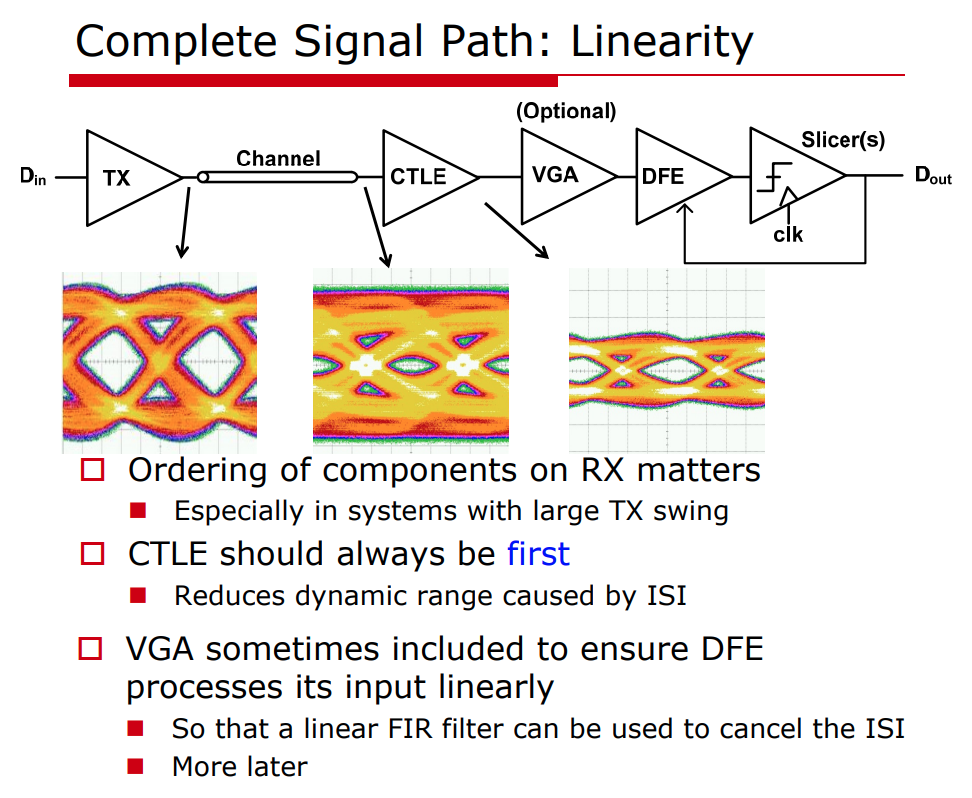
Linearity can actually be a critical constraint in these signal paths, and you really want to stay as linear as you can all the way up until the point where you've canceled all of the ISI
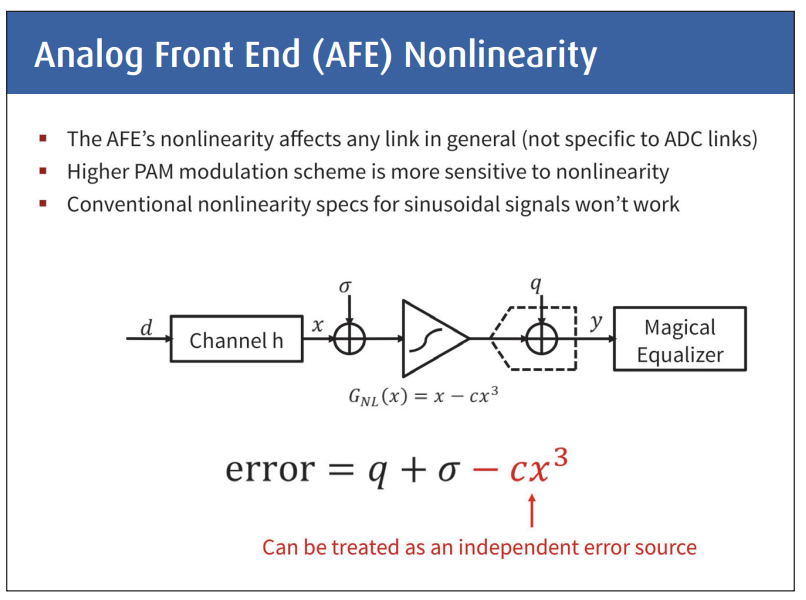
A. Roshan-Zamir, O. Elhadidy, H. -W. Yang and S. Palermo, "A Reconfigurable 16/32 Gb/s Dual-Mode NRZ/PAM4 SerDes in 65-nm CMOS," in IEEE Journal of Solid-State Circuits, vol. 52, no. 9, pp. 2430-2447, Sept. 2017 [https://people.engr.tamu.edu/spalermo/ecen689/2017_reconfigurable_16_32Gbps_NRZ_PAM4_SERDES_roshanzamir_jssc.pdf]
Hongtao Zhang, designcon2016. "PAM4 Signaling for 56G Serial Link Applications − A Tutorial"[https://www.xilinx.com/publications/events/designcon/2016/slides-pam4signalingfor56gserial-zhang-designcon.pdf]
Elad Alon, ISSCC 2014, "T6: Analog Front-End Design for Gb/s Wireline Receivers"
BER with Quantization Noise
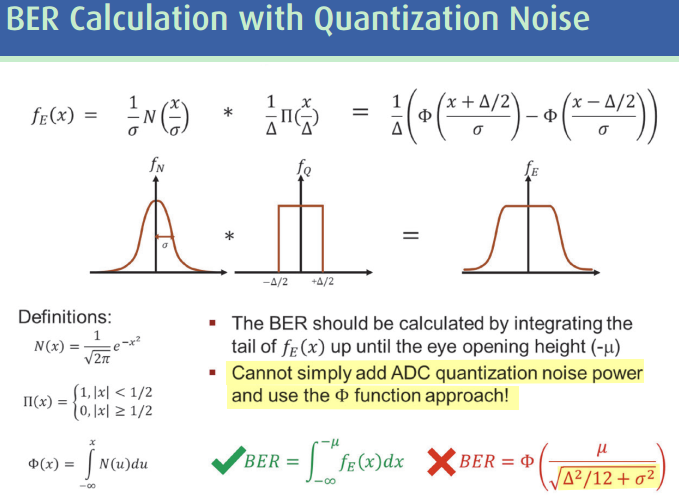
\[ \text{Var}(X) = E[X^2] - E[X]^2 \]
Impulse Response or Pulse Response
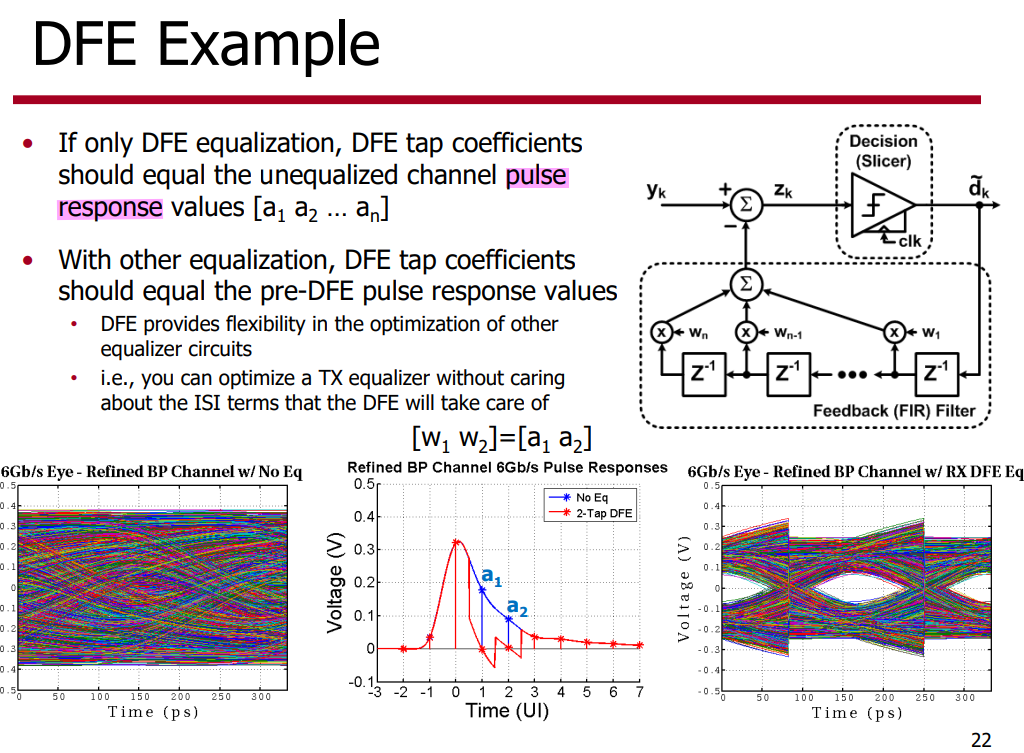
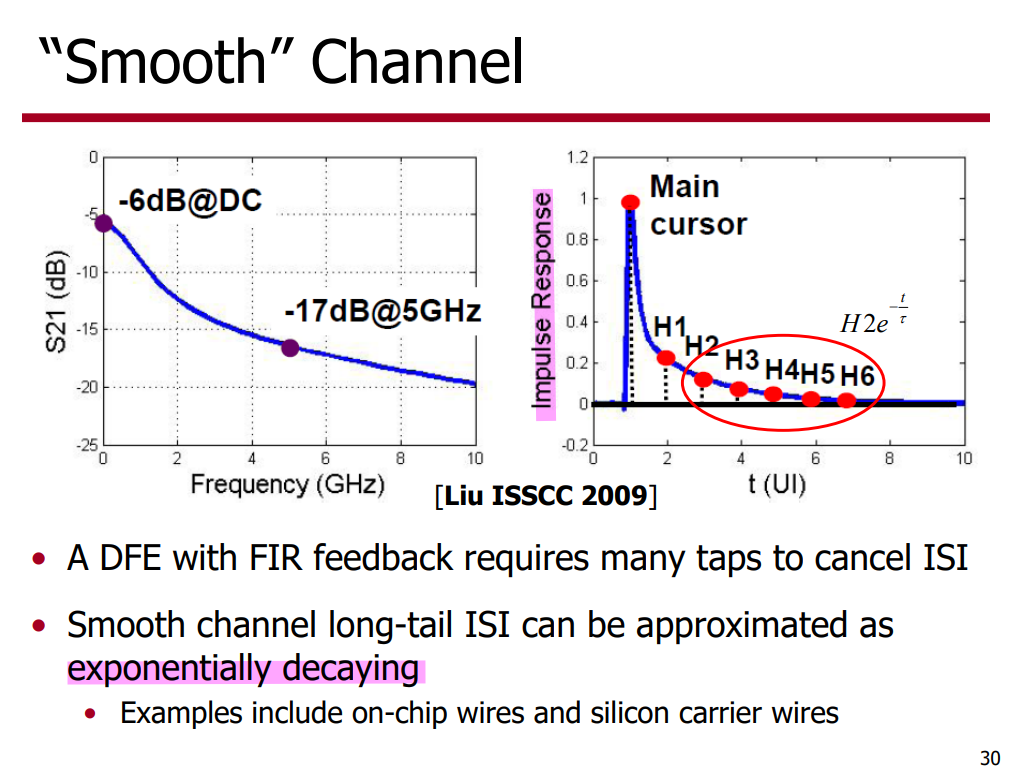
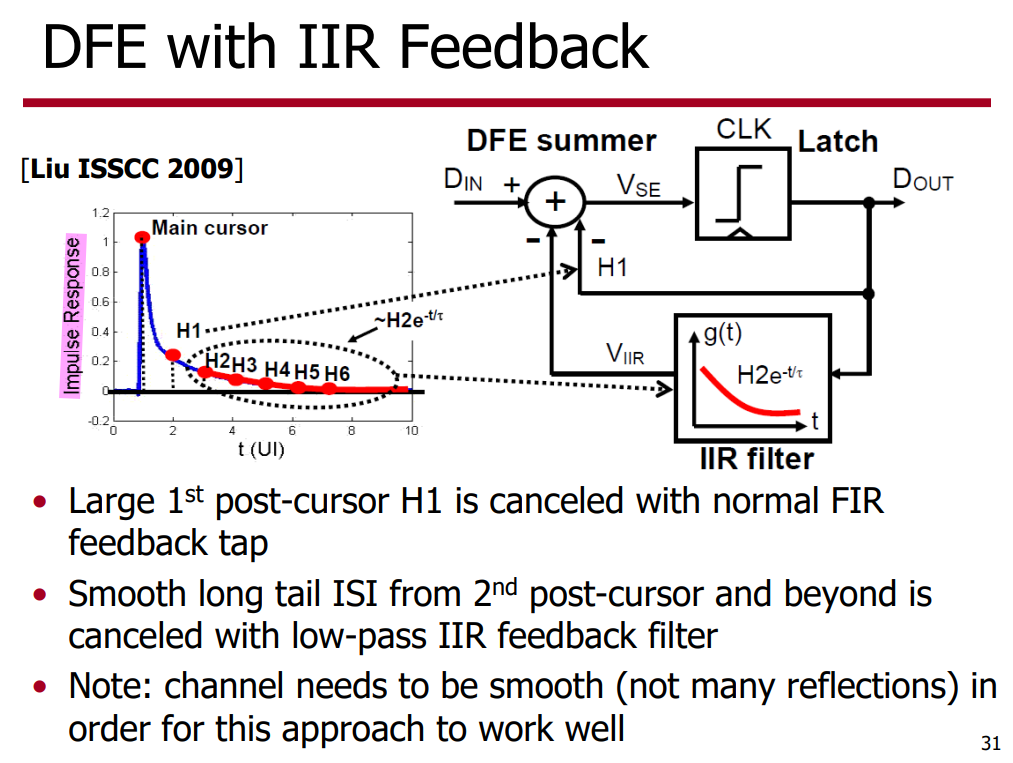
TX FFE
TX FFE suffers from the peak power constraint, which in effect attenuates the average power of the outgoing signal - the low-frequency signal content has been attenuated down to the high-frequency level
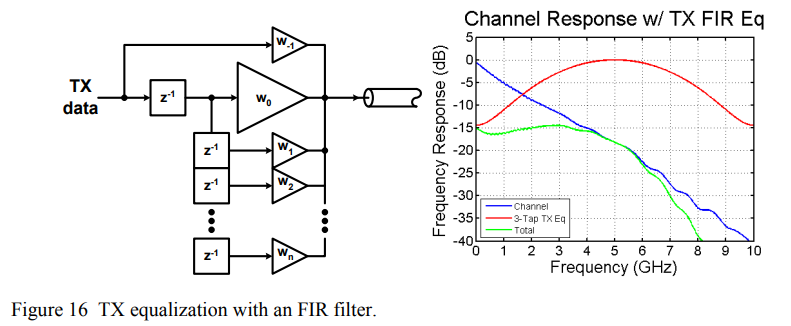
S. Palermo, "CMOS Nanoelectronics Analog and RF VLSI Circuits," Chapter 9: High-Speed Serial I/O Design for Channel-Limited and Power-Constrained Systems, McGraw-Hill, 2011.
Eye-Opening Monitor (EOM)
An architecture that evaluates the received signal quality
data slicers, phase slicers, error slicers, scope slicers
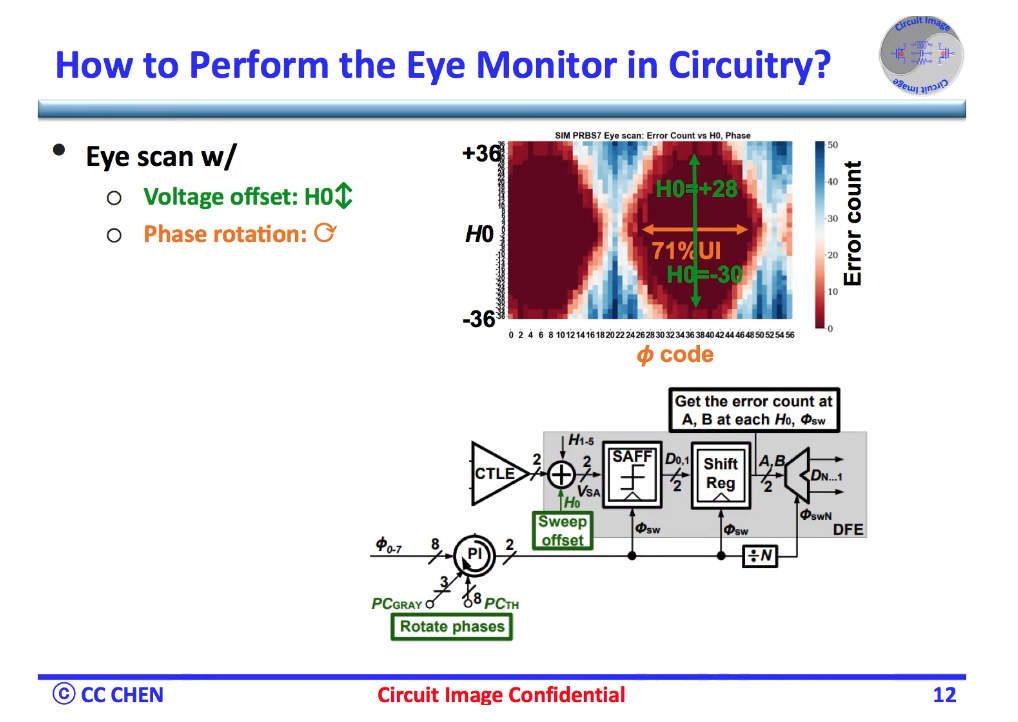
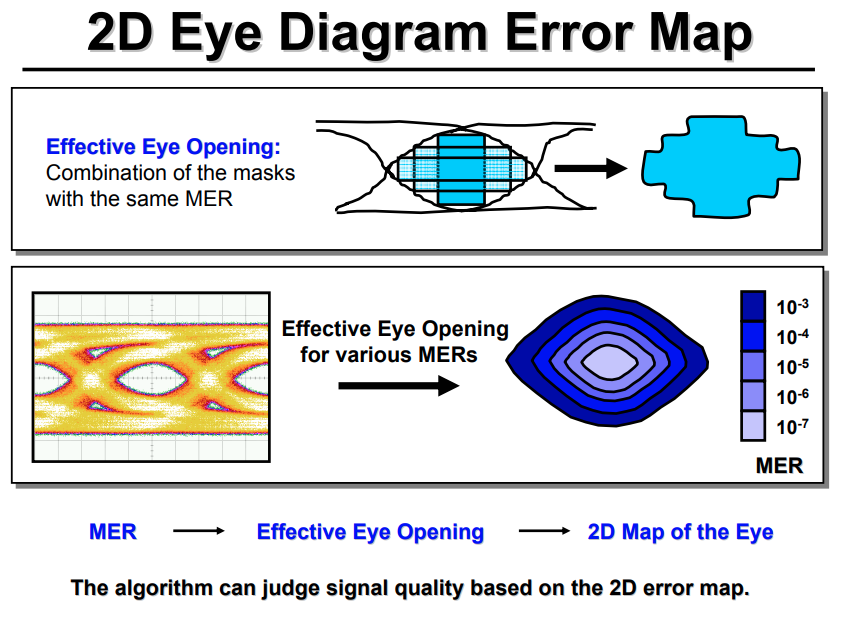
Analui, Behnam & Rylyakov, Alexander & Rylov, Sergey & Meghelli, Mounir & Hajimiri, Ali. (2006). A 10-Gb/s two-dimensional eye-opening monitor in 0.13-??m standard CMOS. Solid-State Circuits, IEEE Journal of. 40. 2689 - 2699, [https://chic.caltech.edu/wp-content/uploads/2013/05/B-Analui_JSSC_10-Gbs_05.pdf]
reference
G. Balamurugan, A. Balankutty and C. -M. Hsu, "56G/112G Link Foundations Standards, Link Budgets & Models," 2019 IEEE Custom Integrated Circuits Conference (CICC), Austin, TX, USA, 2019, pp. 1-95 [https://youtu.be/OABG3u2H2J4?si=CxryBSGbxrUpZNBT] [https://picture.iczhiku.com/resource/ieee/SHKhwYfGotkIymBx.pdf]
Paul Muller Yusuf Leblebici École Polytechnique Fédérale de Lausanne (EPFL). Pattern generator model for jitter-tolerance simulation; VHDL-AMS models
Anritsu Company, "Measuring Channel Operating Margin," 2016. [https://dl.cdn-anritsu.com/en-us/test-measurement/files/Technical-Notes/White-Paper/11410-00989A.pdf]
Kiran Gunnam, Selected Topics in RF, Analog and Mixed Signal Circuits and Systems
H. Shakiba, D. Tonietto and A. Sheikholeslami, "High-Speed Wireline Links-Part I: Modeling," in IEEE Open Journal of the Solid-State Circuits Society, vol. 4, pp. 97-109, 2024 [https://ieeexplore.ieee.org/stamp/stamp.jsp?arnumber=10608184]
H. Shakiba, D. Tonietto and A. Sheikholeslami, "High-Speed Wireline Links-Part II: Optimization and Performance Assessment," in IEEE Open Journal of the Solid-State Circuits Society, vol. 4, pp. 110-121, 2024 [https://ieeexplore.ieee.org/stamp/stamp.jsp?tp=&arnumber=10579874]
G. Souliotis, A. Tsimpos and S. Vlassis, "Phase Interpolator-Based Clock and Data Recovery With Jitter Optimization," in IEEE Open Journal of Circuits and Systems, vol. 4, pp. 203-217, 2023 [https://ieeexplore.ieee.org/stamp/stamp.jsp?tp=&arnumber=10184121]
loop dynamic
Hanumolu, Pavan Kumar. 2006. Design Techniques for Clocking High Performance Signaling Systems. : Oregon State University. https://ir.library.oregonstate.edu/concern/graduate_thesis_or_dissertations/1v53k219r]
Hae-Chang Lee, "An Estimation Approach To Clock And Data Recovery" [https://www-vlsi.stanford.edu/people/alum/pdf/0611_HaechangLee_Phase_Estimation.pdf]
R. Walker, “Designing Bang-Bang PLLs for Clock and Data Recovery in Serial Data Transmission Systems,” in Phase-Locking in High-Performance Systems, B. Razavi, Ed. New Jersey: IEEE Press, 2003, pp. 34-45. [http://www.omnisterra.com/walker/pdfs.papers/BBPLL.pdf]
J. Kim, Design of CMOS Adaptive-Supply Serial Links, Ph.D. Thesis, Stanford University, December 2002. [https://www-vlsi.stanford.edu/people/alum/pdf/0212_Kim_______Design_Of_CMOS_AdaptiveSu.pdf]
P. K. Hanumolu, M. G. Kim, G. -y. Wei and U. -k. Moon, "A 1.6Gbps Digital Clock and Data Recovery Circuit," IEEE Custom Integrated Circuits Conference 2006, San Jose, CA, USA, 2006, pp. 603-606 [https://sci-hub.se/10.1109/CICC.2006.320829]
Da Dalt N. A design-oriented study of the nonlinear dynamics of digital bang-bang PLLs. IEEE Transactions on Circuits and Systems I: Regular Papers. 2005;52(1):21–31. [https://sci-hub.se/10.1109/TCSI.2004.840089]
Jang S, Kim S, Chu SH, Jeong GS, Kim Y, Jeong DK. An optimum loop gain tracking all-digital PLL using autocorrelation of bang–bang phase frequency detection. IEEE Transactions on Circuits and Systems II: Express Briefs. 2015;62(9):836–840. [https://sci-hub.se/10.1109/TCSII.2015.2435691]
CDR Loop Latency
Denoting the CDR loop latency by \(\Delta T\) , we note that the loop transmission is multiplied by \(exp(-s\Delta T)\simeq 1-s\Delta T\).The resulting right-half-plane zero, \(f_z\) degrades the phase margin and must remain about one decade beyond the BW \[ f_z\simeq \frac{1}{2\pi \Delta T} \]
This assumption is true in practice since the bandwidth of the CDR (few mega Hertz) is much smaller than the data rate (multi giga bits/second).
Fernando , Marvell Italy."Considerations for CDR Bandwidth Proposal" [https://www.ieee802.org/3/bs/public/16_03/debernardinis_3bs_01_0316.pdf]
Loop Bandwidth
The closed-loop −3-dB bandwidth is sometimes called the “loop bandwidth”
Continuous-Time Approximation Limitations
A rule of thumb often used to ensure slow changes in the loop is to select the loop bandwidth approximately equal to one-tenth of the input frequency.
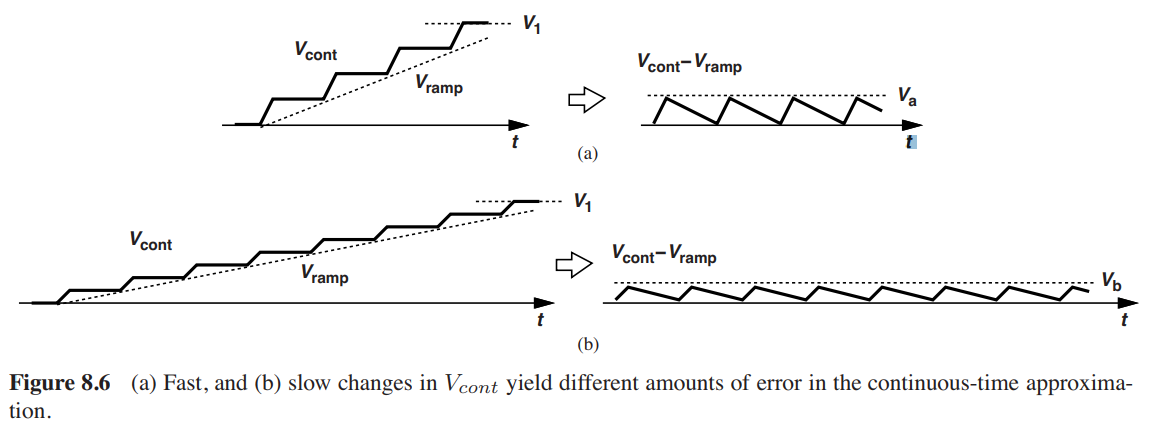
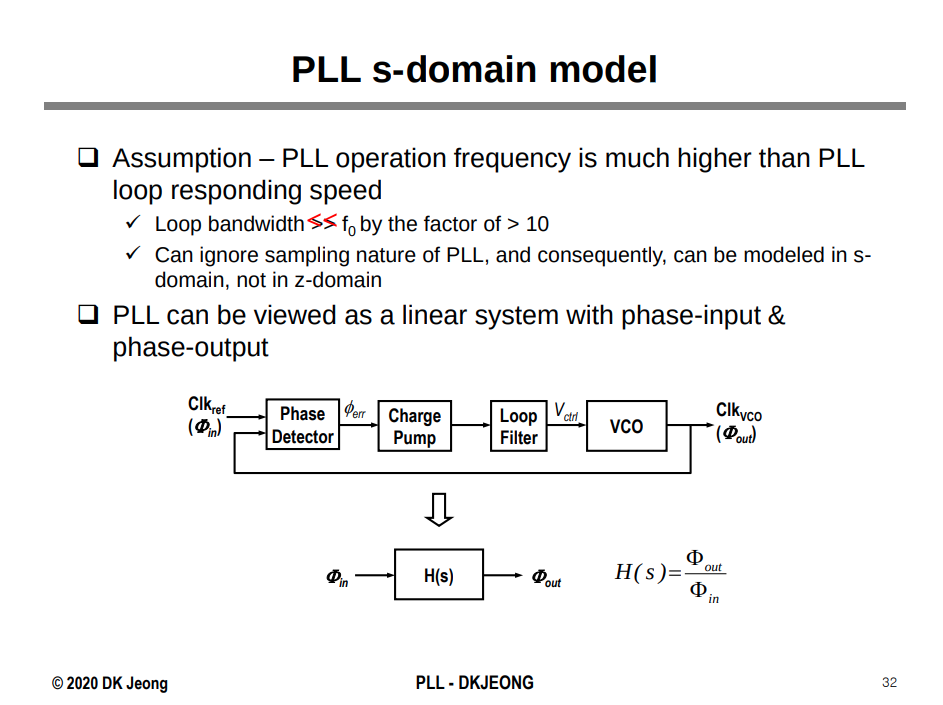
Gardner, F.M. (1980). Charge-Pump Phase-Lock Loops. IEEE Trans. Commun., 28, 1849-1858.
Homayoun, Aliakbar and Behzad Razavi. “On the Stability of Charge-Pump Phase-Locked Loops.” IEEE Transactions on Circuits and Systems I: Regular Papers 63 (2016): 741-750.
N. Kuznetsov, A. Matveev, M. Yuldashev and R. Yuldashev, "Nonlinear Analysis of Charge-Pump Phase-Locked Loop: The Hold-In and Pull-In Ranges," in IEEE Transactions on Circuits and Systems I: Regular Papers, vol. 68, no. 10, pp. 4049-4061, Oct. 2021
Deog-Kyoon Jeong, Topics in IC Design - 2.1 Introduction to Phase-Locked Loop [https://ocw.snu.ac.kr/sites/default/files/NOTE/Lec%202%20-%20Charge-Pump%20PLL%2C%20Freuqency%20Synthesizers%2C%20and%20SSCG.pdf]
Limit Cycle Oscillation
limit cycles imply self-sustained oscillators due nonlinear nature
Ouzounov, S., Hegt, H., Van Roermund, A. (2007). SUB-HARMONIC LIMIT-CYCLE SIGMA-DELTA MODULATION, APPLIED TO AD CONVERSION. In: Van Roermund, A.H., Casier, H., Steyaert, M. (eds) Analog Circuit Design. Springer, Dordrecht. [https://sci-hub.se/10.1007/1-4020-5186-7_6]
Digital CDR Category
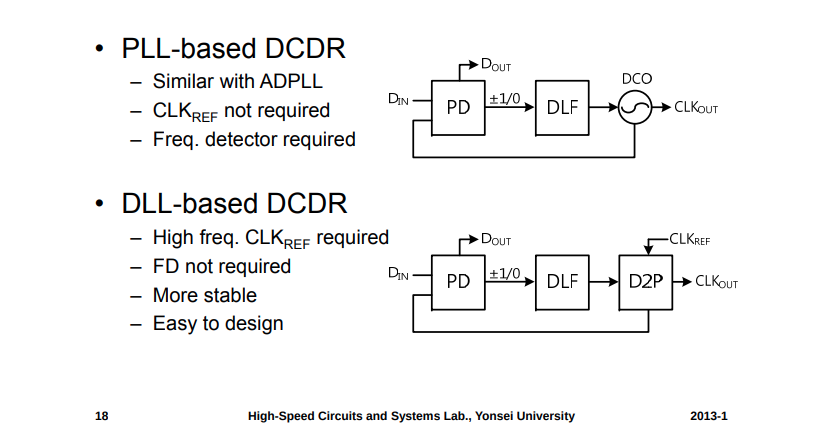
- DCO part is analogous so that it cannot be perfectly modeled
- Digital-to-phase converter is well-defined phase output, thus, very good to model real situation
Z-domain modeling
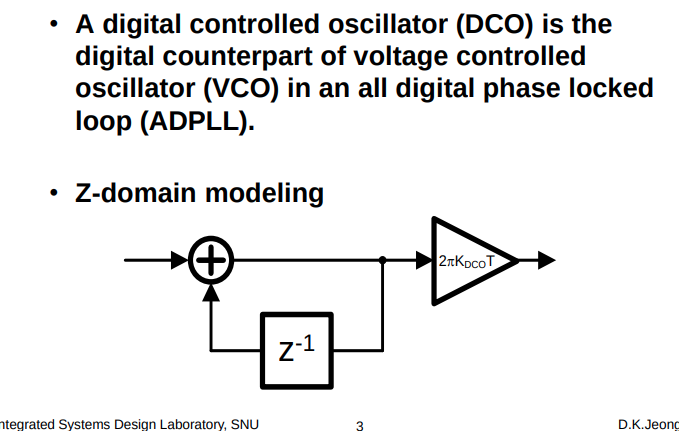
The difference equation is \[ \phi[n] = \phi[n-1] + K_{DCO}V_C[n]\cdot T\cdot2\pi \] z-transform is \[ \frac{\Phi(z)}{V_C(z)}=\frac{2\pi K_{DCO}T}{1-z^{-1}} \]
where \(K_{DCO}\) : \(\Delta f\) (Hz/bit)
\(\Delta \Sigma\)-dithering in DCO
Quantization noise

Here, \(\alpha_T\) is data transition density
BBPD quantization noise
DAC quantization noise
M. -J. Park and J. Kim, "Pseudo-Linear Analysis of Bang-Bang Controlled Timing Circuits," in IEEE Transactions on Circuits and Systems I: Regular Papers, vol. 60, no. 6, pp. 1381-1394, June 2013 [https://sci-hub.st/10.1109/TCSI.2012.2220502]
Time to Digital Converter (TDC)
Digital to Phase Converter (DPC)
IIR low pass filter
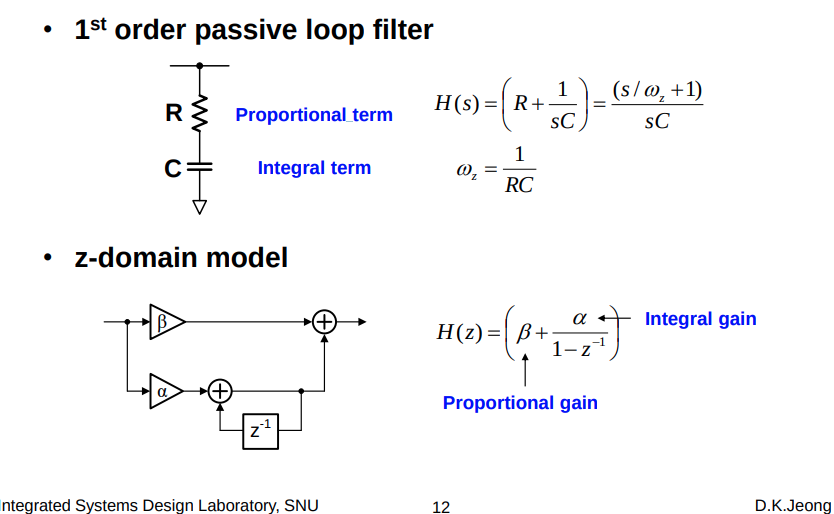
simple approximation: \[ z = 1 + sT \] bilinear-z transform \[ z =\frac{}{} \]
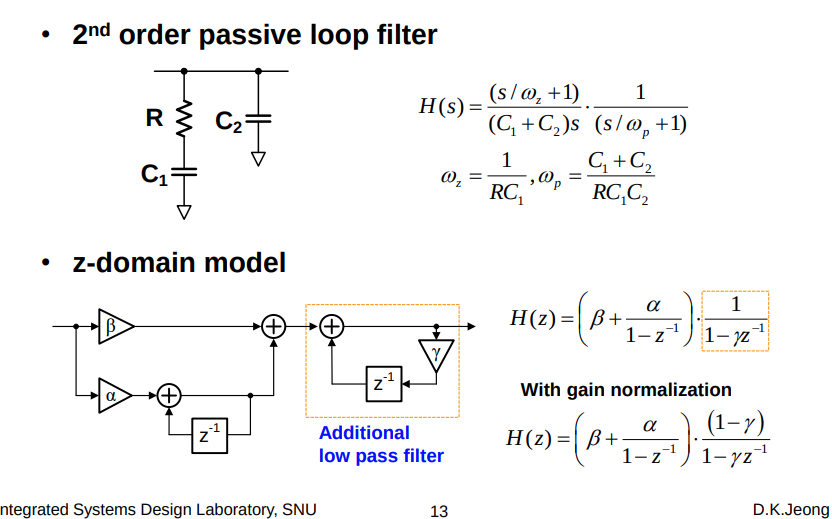
Accumulate-and-dump (AAD) decimator
accumulating the input for \(N\) cycles and then latching the result and resetting the integrator
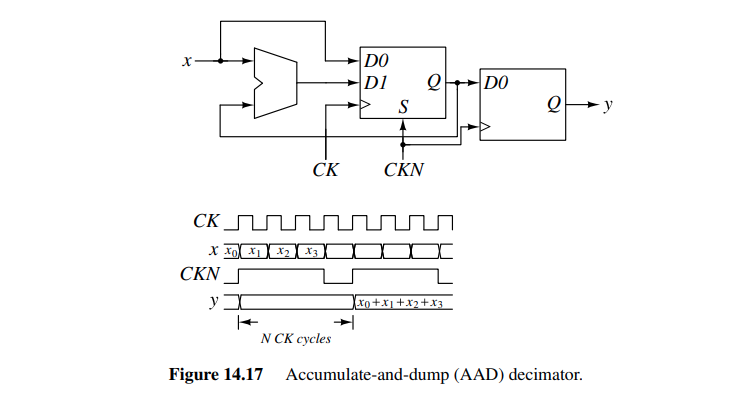
It adds up \(N\) succeeding input samples at rate \(1/T\) and delivers their sum in a single sample at the output. Therefore, the process comprises a filter (in the accumulation) and a down-sampler (in the dump)
Moving Average and CIC Filters
cascade-integrator-comb (CIC) decimator
TODO 📅
An Intuitive Look at Moving Average and CIC Filters [web, code]
A Beginner's Guide To Cascaded Integrator-Comb (CIC) Filters [https://www.dsprelated.com/showarticle/1337.php]
FAQ
PLL vs. CDR
| PLL | CDR |
|---|---|
| Clock edge periodic | Data edge random |
| Phase & Frequency detecting possible | Phase detecting possible , Frequency detecting impossible |
PLL or FD(Frequency Detector) for frequency detecting in CDR
reference
J. Stonick. ISSCC 2011 "DPLL-Based Clock and Data Recovery" [slides,transcript]
P. Hanumolu. ISSCC 2015 "Clock and Data Recovery Architectures and Circuits" [slides]
Amir Amirkhany. ISSCC 2019 "Basics of Clock and Data Recovery Circuits"
Fulvio Spagna. INTEL, CICC2018, "Clock and Data Recovery Systems" [slides]
M. Perrott. 6.976 High Speed Communication Circuits and Systems (lecture 21). Spring 2003. Massachusetts Institute of Technology: MIT OpenCourseWare, [lec21.pdf]
Akihide Sai. ISSCC 2023, T5 "All Digital Plls From Fundamental Concepts To Future Trends" [T5.pdf]
J. L. Sonntag and J. Stonick, "A Digital Clock and Data Recovery Architecture for Multi-Gigabit/s Binary Links," in IEEE Journal of Solid-State Circuits, vol. 41, no. 8, pp. 1867-1875, Aug. 2006 [https://sci-hub.se/10.1109/JSSC.2006.875292]
—, "A digital clock and data recovery architecture for multi-gigabit/s binary links," Proceedings of the IEEE 2005 Custom Integrated Circuits Conference, 2005.. [https://sci-hub.se/10.1109/CICC.2005.1568725]
Fernando De Bernardinis, eSilicon. "Introduction to DSP Based Serial Links" [https://www.corsi.univr.it/documenti/OccorrenzaIns/matdid/matdid835215.pdf]
Yohan Frans, CICC2019 ES3-3- "ADC-based Wireline Transceivers" [pdf]
H. Kang et al., "A 42.7Gb/s Optical Receiver With Digital Clock and Data Recovery in 28nm CMOS," in IEEE Access, vol. 12, pp. 109900-109911, 2024 [https://ieeexplore.ieee.org/stamp/stamp.jsp?arnumber=10630516]
Marinaci, Stefano. "Study of a Phase Locked Loop based Clock and Data Recovery Circuit for 2.5 Gbps data-rate" [https://cds.cern.ch/record/2870334/files/CERN-THESIS-2023-147.pdf]
P. Palestri et al., "Analytical Modeling of Jitter in Bang-Bang CDR Circuits Featuring Phase Interpolation," in IEEE Transactions on Very Large Scale Integration (VLSI) Systems, vol. 29, no. 7, pp. 1392-1401, July 2021 [https://sci-hub.se/10.1109/TVLSI.2021.3068450]
F. M. Gardner, "Phaselock Techniques", 3rd Edition, Wiley Interscience, Hoboken, NJ, 2005 [https://picture.iczhiku.com/resource/eetop/WyIgwGtkDSWGSxnm.pdf]
Rhee, W. (2020). Phase-locked frequency generation and clocking : architectures and circuits for modern wireless and wireline systems. The Institution of Engineering and Technology
M.H. Perrott, Y. Huang, R.T. Baird, B.W. Garlepp, D. Pastorello, E.T. King, Q. Yu, D.B. Kasha, P. Steiner, L. Zhang, J. Hein, B. Del Signore, "A 2.5 Gb/s Multi-Rate 0.25μm CMOS Clock and Data Recovery Circuit Utilizing a Hybrid Analog/Digital Loop Filter and All-Digital Referenceless Frequency Acquisition," IEEE J. Solid-State Circuits, vol. 41, Dec. 2006, pp. 2930-2944 [https://cppsim.com/Publications/JNL/perrott_jssc06.pdf]
M.H. Perrott. CICC 2009 "Tutorial on Digital Phase-Locked Loops" [https://www.cppsim.com/PLL_Lectures/digital_pll_cicc_tutorial_perrott.pdf]
—, Short Course On Phase-Locked Loops and Their Applications Day 4, PM Lecture "Examples of Leveraging Digital Techniques in PLLs" [https://www.cppsim.com/PLL_Lectures/day4_pm.pdf]
—, Short Course On Phase-Locked Loops IEEE Circuit and System Society, San Diego, CA "Digital Frequency Synthesizers" [https://www.cppsim.com/PLL_Lectures/digital_pll.pdf]
Gain Kim, "Equalization, Architecture, and Circuit Design for High-Speed Serial Link Receiver" [pdf]
Deog-Kyoon Jeong Topics in IC(Wireline Transceiver Design) - 3.1. Introduction to All Digital PLL [https://ocw.snu.ac.kr/sites/default/files/NOTE/Lec%203%20-%20ADPLL.pdf]
—, Topics in IC(Wireline Transceiver Design) - 6.1 Introduction to Clock and Data Recovery [https://ocw.snu.ac.kr/sites/default/files/NOTE/Lec%206%20-%20Clock%20and%20Data%20Recovery.pdf]
High-speed Serial Interface Lect. 16 – Clock and Data Recovery 3 [http://tera.yonsei.ac.kr/class/2013_1_2/lecture/Lect16_CDR-3.pdf]
Shiva Kiran. Phd thesis 2018. Modeling and Design of Architectures for High-Speed ADC-Based Serial Links [https://hdl.handle.net/1969.1/192031]
—, et al., "Modeling of ADC-Based Serial Link Receivers With Embedded and Digital Equalization," in IEEE Transactions on Components, Packaging and Manufacturing Technology, vol. 9, no. 3, pp. 536-548, March 2019 [https://sci-hub.se/10.1109/TCPMT.2018.2853080]
K. Zheng, "System-Driven Circuit Design for ADC-Based Wireline Data Links", Ph.D. Dissertation, Stanford University, 2018 [https://purl.stanford.edu/hw458fp0168]
S. Cai, A. Shafik, S. Kiran, E. Z. Tabasy, S. Hoyos and S. Palermo, "Statistical modeling of metastability in ADC-based serial I/O receivers," 2014 IEEE 23rd Conference on Electrical Performance of Electronic Packaging and Systems [pdf]
John M. Cioffi. "Decoding Methods" [https://cioffi-group.stanford.edu/doc/book/chap7.pdf]
—. "Equalization" [https://cioffi-group.stanford.edu/doc/book/chap3.pdf]
Iain. [https://youtu.be/rnjy4_gXLAg?si=PC3aowaon-e_mhXX]
—. [https://youtu.be/IJE94FhyygM?si=BMMQ-GmirBWNf4ep]
Noman Hai, Synopsys, Canada CASS Talks 2025 - May 2, 2025: High-speed Wireline Interconnects: Design Challenges and Innovations in 224G SerDes [https://www.youtube.com/live/wHNOlxHFTzY?si=179HZozbtW59H8Lm]
